Paul van Yperen's Blog, page 19
April 1, 2025
Ross Verlag, Part 29: Bunte Filmbilder
Ross Verlag published several series of cigarette cards, which were much smaller than the famous Ross postcards. These cards (app. 7 x 5,5 cm or 28 x 22, 5 inches) were sold in packs or cartons of cigarettes in Germany and a few other countries. One of the series was called Bunte Filmbilder (Colourful Film Pictures) of which we know two series with both Hollywood and European stars. The cards have numbers on the back and were meant to be pasted into a book. The book for the second series was published in 1936. Some pictures were duplicates of photos seen on postcards, but others were designed just for the cigarette cards, which were printed for different tobacco brands.With twenty of these wonderful and indeed colourful film pictures, EFSP finishes our Ross Verlag Tribute.
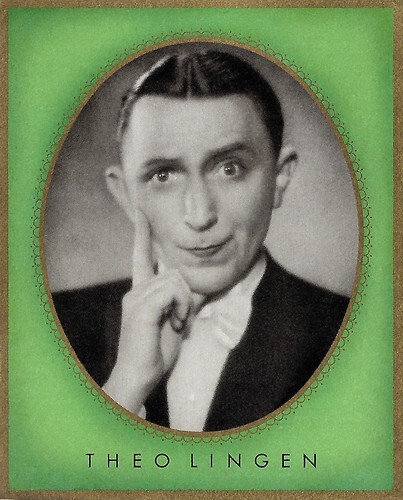
Theo Lingen . German collector card by Ross Verlag in the Bunte Filmbilder series for Martin Brinkmann A.G., Bremen, no. 53. Photo: Projektograph-Film. Theo Lingen in Wer zuletzt küßt… / Who Kisses Last... (E.W. Emo, 1936).
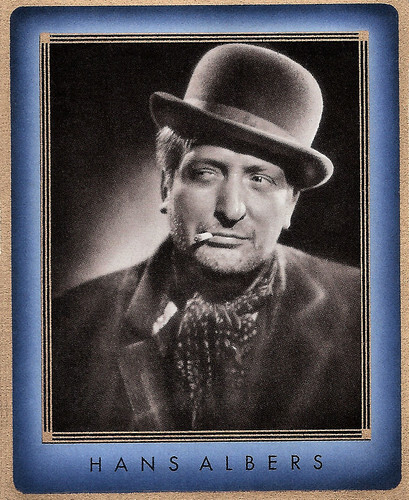
Hans Albers . German collector card by Ross Verlag in the Bunte Filmbilder series for G. Zuban, München, no. 115. Photo: Ufa.
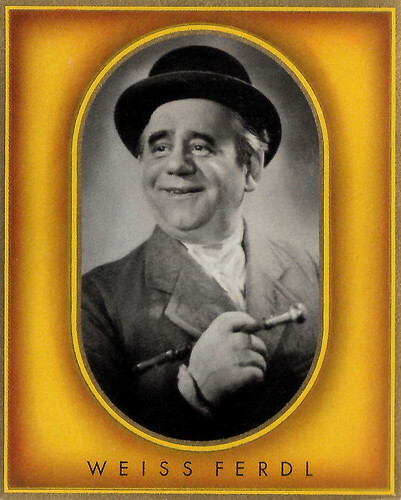
Weiss Ferdl. German collector card by Ross Verlag in the Bunte Filmbilder series for Greiling AG, no. 152. Photo: Majestic-Syndikat-Film.
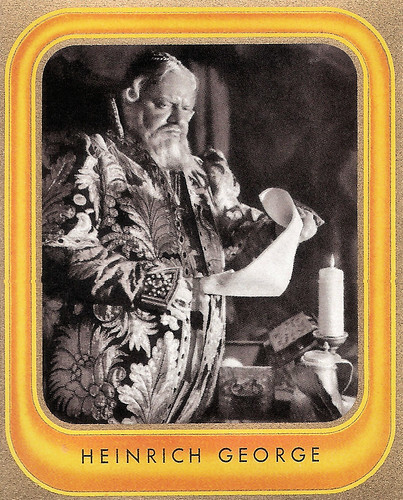
Heinrich George . German collector card by Ross Verlag in the Bunte Filmbilder series for G. Zuban, München, no. 190. Photo: Badal / Terra. Heinrich George in Stjenka Rasin/Stenka Rasin (Alexandre Volkoff, 1936).
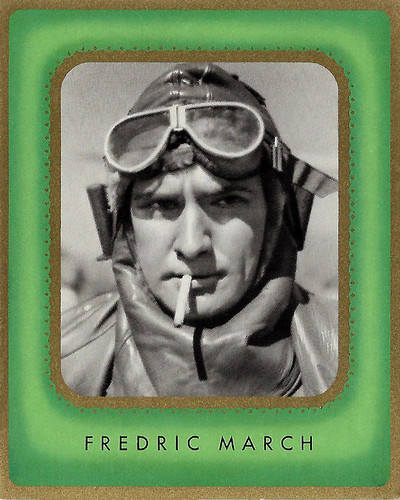
Fredric March . German collector card by Ross Verlag in the Bunte Filmbilder series for Lloyd Zigaretten, no. 212. Photo: Paramount. Fredric March in The Eagle and the Hawk (Stuart Walker, 1933).
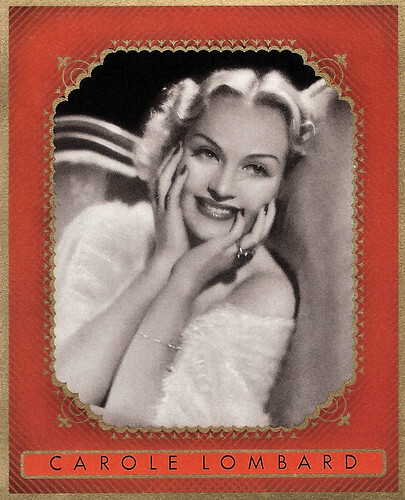
Carole Lombard . German collector card by Ross Verlag in the Bunte Filmbilder series for Greilingen-Zigaretten, Series no. 2, no. 259. Photo: Paramount.
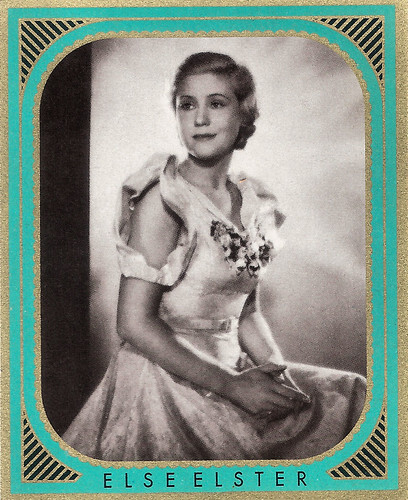
Else Elster . German collector card by Ross Verlag in the Bunte Filmbilder series for Caid Zigaretten, Series no. 2, no. 323. Photo: Schulz and Wuellner.
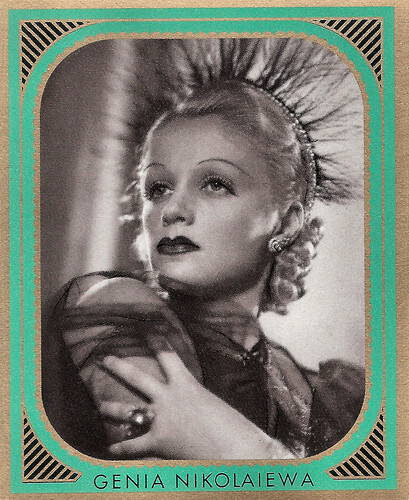
Genia Nikolaieva . German collector card by Ross Verlag in the Bunte Filmbilder series for Greiling-Zigaretten, Series no. 2, no. 358. Photo: Ufa.
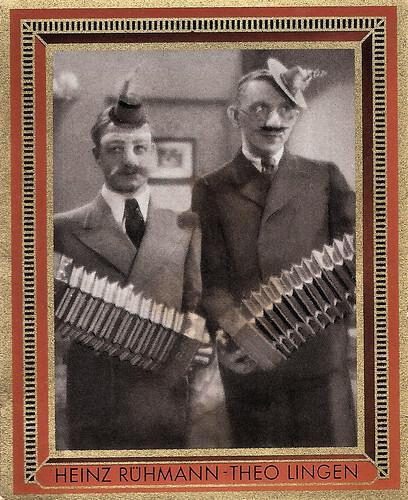
Heinz Rühmann and Theo Lingen . German collector card by Ross Verlag in the Bunte Filmbilder series for Drama Zigaretten, Series no. 2, no. 360. Photo: Projectograph-Film.
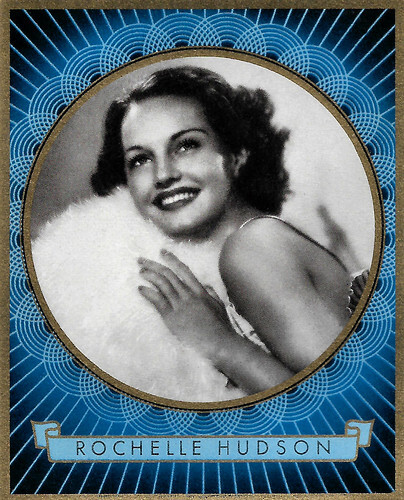
Rochelle Hudson . German collector card by Ross Verlag in the Bunte Filmbilder series for Lloyd Zigaretten, Series no. 2, no. 374. Photo: Fox-Film.
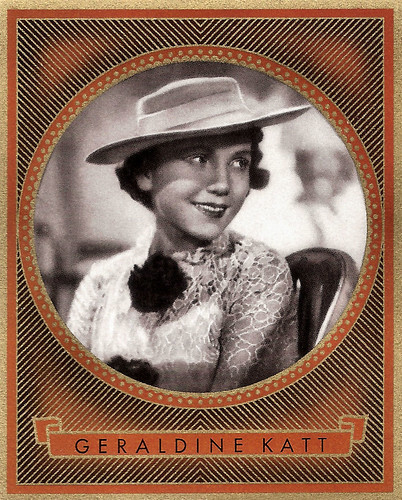
Geraldine Katt . German collector card by Ross Verlag in the Bunte Filmbilder series for Greiling-Zigaretten, Series no. 2, no. 383. Photo: Bavaria. Geraldine Katt in Die Stimme des Herzens/The Voice of the Heart (Karl Heinz Martin, 1937).
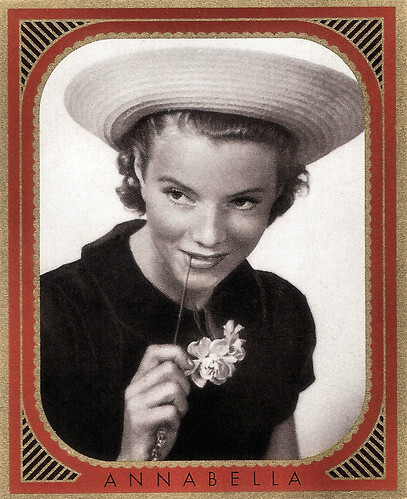
Annabella . German collector card by Ross Verlag in the Bunte Filmbilder series for Greiling-Zigaretten, Series no. 2, no. 384. Photo: New World Pictures.
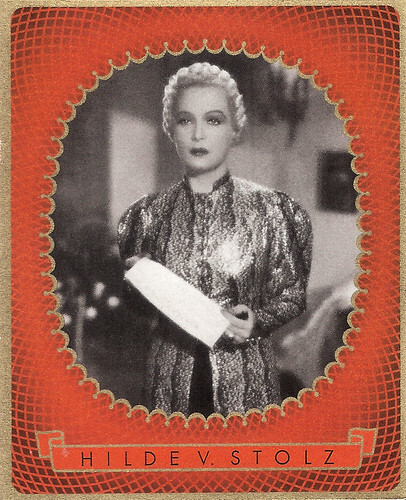
Hilde von Stolz . German collector card by Ross Verlag in the Bunte Filmbilder series for Caid, Series 2, no. 394. Photo: Bavaria.
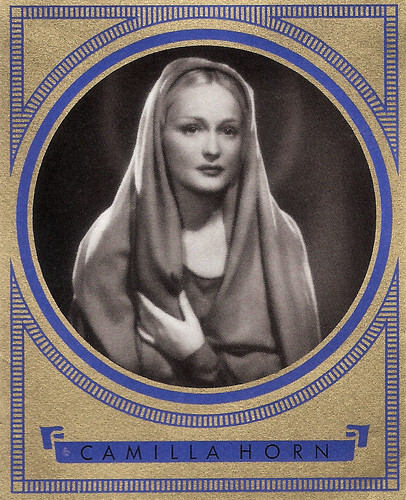
Camilla Horn . German collector card by Ross Verlag in the Bunte Filmbilder series for Cigarettenfabrik Caid, Series 2, no. 402. Photo: Bavaria. Camilla Horn in Sein letztes Modell/His Last Model (Rudolf van der Noss, 1937).
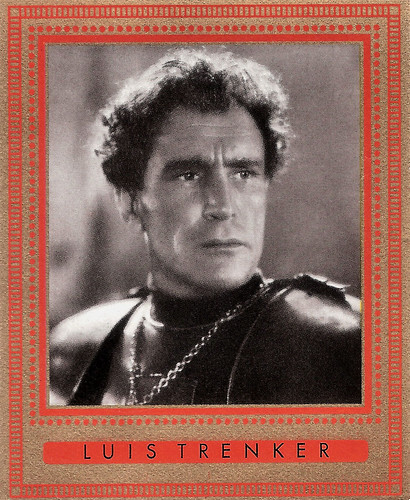
Luis Trenker . German collector card by Ross Verlag in the Bunte Filmbilder series for Greiling Zigaretten, Series no. 2, no. 403. Photo: Trenker / Tobis / Rota.
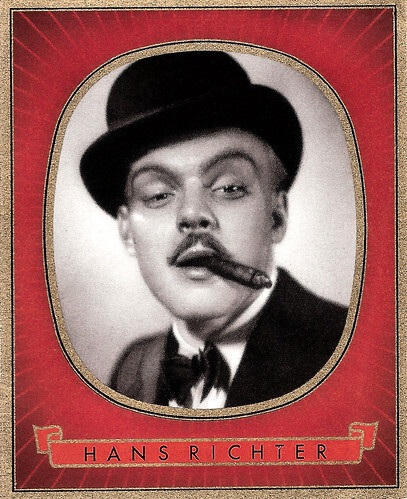
Hans Richter . German collector card by Ross Verlag in the Bunte Filmbilder series for Drama Zigaretten, Series no. 2, no. 459. Photo: Cando-Film.
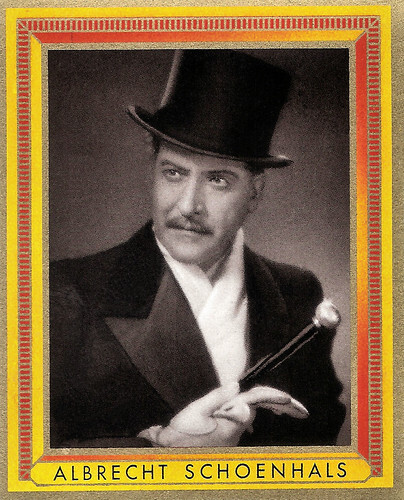
Albrecht Schoenhals . German collector card by Ross Verlag in the Bunte Filmbilder series for Greilingen Zigaretten, Series no. 2, no. 465. Photo: Deka-Syndikat-Film.
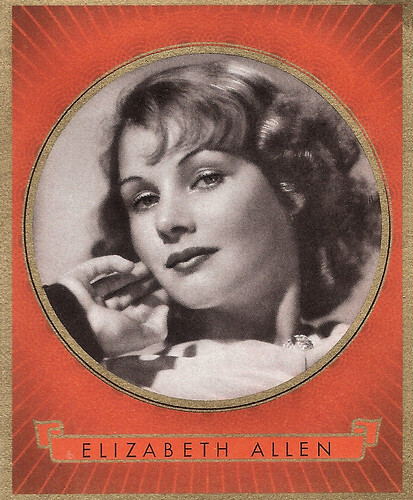
Elizabeth Allan . German collector card by Ross Verlag in the Bunte Filmbilder series for Greiling-Zigaretten, Series no. 2, no. 484. Photo: Styria-Film.
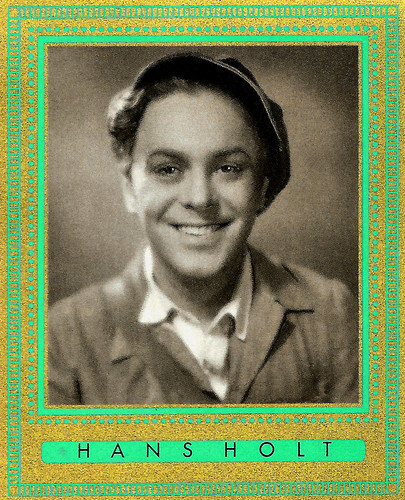
Hans Holt . German collector card by Ross Verlag in the Bunte Filmbilder series for Caid, Series no. 2, no. 491. Photo: Styria-Film. Hans Holt in Lumpacivagabundus/Lumpaci the Vagabond (Géza von Bolváry, 1936).
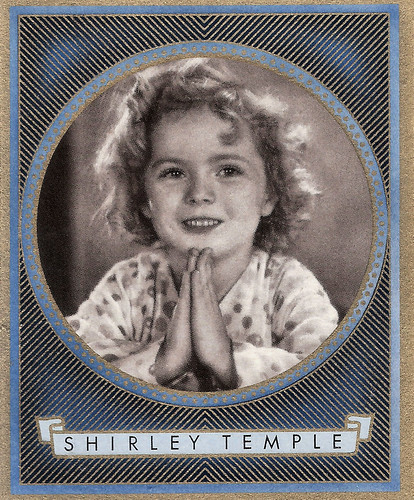
Shirley Temple . German collector card by Ross Verlag in the Bunte Filmbilder series for Caid, Series no. 2, no. 496. Photo: Fox-Film.
Source: Mark Goffee (Ross Verlag Movie Star Postcards). This was the last post in our Ross Verlag Tribute!

Theo Lingen . German collector card by Ross Verlag in the Bunte Filmbilder series for Martin Brinkmann A.G., Bremen, no. 53. Photo: Projektograph-Film. Theo Lingen in Wer zuletzt küßt… / Who Kisses Last... (E.W. Emo, 1936).

Hans Albers . German collector card by Ross Verlag in the Bunte Filmbilder series for G. Zuban, München, no. 115. Photo: Ufa.

Weiss Ferdl. German collector card by Ross Verlag in the Bunte Filmbilder series for Greiling AG, no. 152. Photo: Majestic-Syndikat-Film.

Heinrich George . German collector card by Ross Verlag in the Bunte Filmbilder series for G. Zuban, München, no. 190. Photo: Badal / Terra. Heinrich George in Stjenka Rasin/Stenka Rasin (Alexandre Volkoff, 1936).

Fredric March . German collector card by Ross Verlag in the Bunte Filmbilder series for Lloyd Zigaretten, no. 212. Photo: Paramount. Fredric March in The Eagle and the Hawk (Stuart Walker, 1933).

Carole Lombard . German collector card by Ross Verlag in the Bunte Filmbilder series for Greilingen-Zigaretten, Series no. 2, no. 259. Photo: Paramount.

Else Elster . German collector card by Ross Verlag in the Bunte Filmbilder series for Caid Zigaretten, Series no. 2, no. 323. Photo: Schulz and Wuellner.

Genia Nikolaieva . German collector card by Ross Verlag in the Bunte Filmbilder series for Greiling-Zigaretten, Series no. 2, no. 358. Photo: Ufa.

Heinz Rühmann and Theo Lingen . German collector card by Ross Verlag in the Bunte Filmbilder series for Drama Zigaretten, Series no. 2, no. 360. Photo: Projectograph-Film.

Rochelle Hudson . German collector card by Ross Verlag in the Bunte Filmbilder series for Lloyd Zigaretten, Series no. 2, no. 374. Photo: Fox-Film.

Geraldine Katt . German collector card by Ross Verlag in the Bunte Filmbilder series for Greiling-Zigaretten, Series no. 2, no. 383. Photo: Bavaria. Geraldine Katt in Die Stimme des Herzens/The Voice of the Heart (Karl Heinz Martin, 1937).

Annabella . German collector card by Ross Verlag in the Bunte Filmbilder series for Greiling-Zigaretten, Series no. 2, no. 384. Photo: New World Pictures.

Hilde von Stolz . German collector card by Ross Verlag in the Bunte Filmbilder series for Caid, Series 2, no. 394. Photo: Bavaria.

Camilla Horn . German collector card by Ross Verlag in the Bunte Filmbilder series for Cigarettenfabrik Caid, Series 2, no. 402. Photo: Bavaria. Camilla Horn in Sein letztes Modell/His Last Model (Rudolf van der Noss, 1937).

Luis Trenker . German collector card by Ross Verlag in the Bunte Filmbilder series for Greiling Zigaretten, Series no. 2, no. 403. Photo: Trenker / Tobis / Rota.

Hans Richter . German collector card by Ross Verlag in the Bunte Filmbilder series for Drama Zigaretten, Series no. 2, no. 459. Photo: Cando-Film.

Albrecht Schoenhals . German collector card by Ross Verlag in the Bunte Filmbilder series for Greilingen Zigaretten, Series no. 2, no. 465. Photo: Deka-Syndikat-Film.

Elizabeth Allan . German collector card by Ross Verlag in the Bunte Filmbilder series for Greiling-Zigaretten, Series no. 2, no. 484. Photo: Styria-Film.

Hans Holt . German collector card by Ross Verlag in the Bunte Filmbilder series for Caid, Series no. 2, no. 491. Photo: Styria-Film. Hans Holt in Lumpacivagabundus/Lumpaci the Vagabond (Géza von Bolváry, 1936).

Shirley Temple . German collector card by Ross Verlag in the Bunte Filmbilder series for Caid, Series no. 2, no. 496. Photo: Fox-Film.
Source: Mark Goffee (Ross Verlag Movie Star Postcards). This was the last post in our Ross Verlag Tribute!
Published on April 01, 2025 22:00
March 31, 2025
Richard Chamberlain (1934-2025)
On 29 March 2025, American actor Richard Chamberlain (1934) passed away. The impeccably handsome Chamberlain was TV's leading heartthrob because of his title role in Dr. Kildare (1961-1966). He turned his back on Hollywood, devoting himself to the stage and a new European film career. Later he became the 'King of the Miniseries'. He was 90.
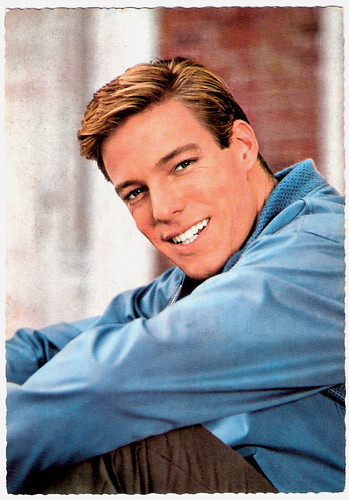
German postcard by Krüger, no. 902/240.
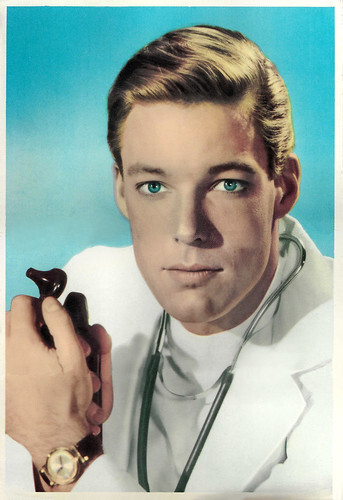
Spanish postcard by Archivo Bermejo, no. C. 174, 1964. Richard Chamberlain in the TV series Dr. Kildare (1961-1966).
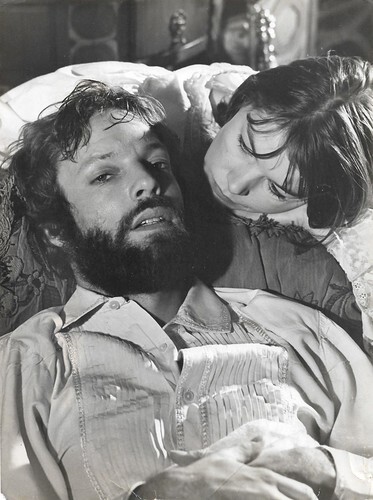
Vintage Spanish photo. Glenda Jackson and Richard Chamberlain in The Music Lovers (Ken Russell, 1971), a biopic on composer Pyotr Ilyich Tchaikovsky.
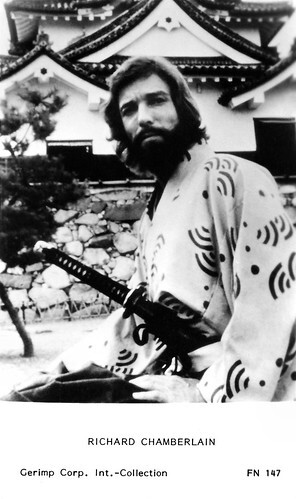
British postcard Gerimp Corp. Int.-Collection, no. FN 147. Richard Chamberlain in Shōgun (1980).
The leading heartthrob of early 1960s television
George Richard Chamberlain was born in 1934 in Beverly Hills, Los Angeles. He was the second son of Elsa Winnifred (von Benzon) and Charles Axiom Chamberlain, who was a salesman. He had a profoundly unhappy childhood and did not enjoy school, making up for it somewhat by excelling in track and developing a strong interest in acting. In 1952, Chamberlain graduated from Beverly Hills High School and in 1956, he graduated from Pomona College in Claremont, California. In December 1956, he was drafted into the United States Army for 16 months, serving in Korea.
Soon after his discharge from the army, Chamberlain headed for Hollywood. In 1959, he co-founded the theatre company the Company of Angels (CoA), now the oldest not-for-profit repertory theatre in Los Angeles. In just a couple of years, Chamberlain worked up a decent resumé with several visible guest spots on such popular series as Alfred Hitchcock Presents (1959), Gunsmoke (1960) and Mr. Lucky (1960). As the star of the medical series Dr. Kildare (1961-1966), he became the leading heartthrob of early 1960s television. As the impeccably handsome Dr. James Kildare, the slim, butter-haired hunk with the near-perfect Ivy-League charm and smooth, intelligent demeanour, had the distaff fans fawning unwavering over him through the series' run.
While this would appear to be a dream situation for any new star, it brought Chamberlain a significant, unsettling identity crisis. More interested in a reputation as a serious actor, Chamberlain took a considerable risk and turned his back on Hollywood, devoting himself to the stage. An important dramatic role opposite Julie Christie in Petulia (Richard Lester, 1968) led him to England. He played a recently divorced doctor who finds solace in the company of an unhappily married socialite.
In the 1970s, Chamberlain enjoyed success as a leading man in European films. He played composer Pyotr Ilyich Tchaikovsky in The Music Lovers (Ken Russell, 1970) opposite Glenda Jackson , Lord Byron alongside Sarah Miles in Lady Caroline Lamb (Robert Bolt, 1972), and Aramis in The Three Musketeers (Richard Lester, 1973) with Michael York as D'Artagnan. The sequel, The Four Musketeers (Richard Lester, 1974), was released the following year.
Then he was the villain in the disaster film The Towering Inferno (John Guillermin, 1974) opposite Steve McQueen and Paul Newman , and Edmond Dantes in The Count of Monte Cristo (David Greene, 1975). In The Slipper and the Rose (Bryan Forbes, 1976), a musical version of the Cinderella story, co-starring Gemma Craven as Cinderella, he displayed his vocal talents as the Prince. In 1977, he earned cult status for the Australian thriller The Last Wave (Peter Weir, 1977). He played a Sydney lawyer who defends five Aboriginal Persons in a ritualised taboo murder and in the process learns disturbing things about himself and premonitions.
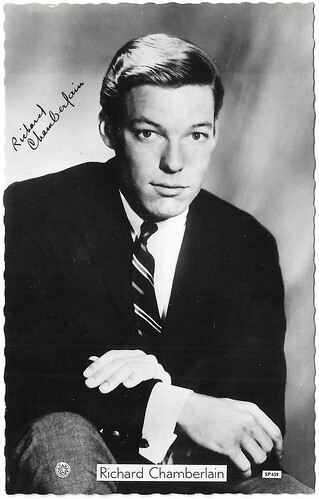
British postcard in the Star Pics series, no. SP459.
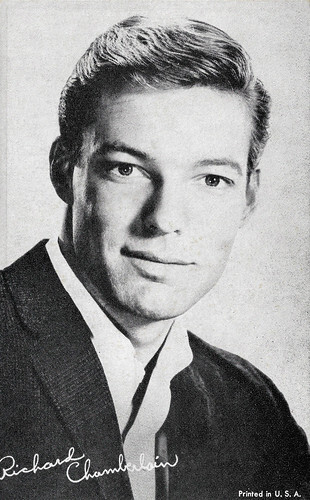
American Arcade card.
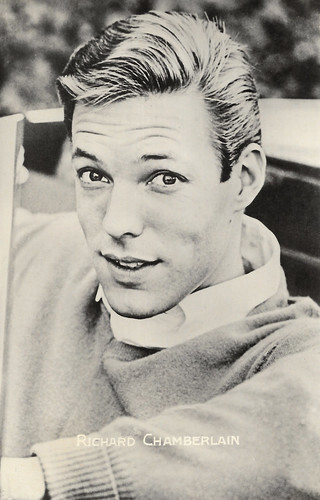
French postcard by Editions P.I., no. S-1679.
Outed at the age of 55
Since then, Richard Chamberlain has appeared in several miniseries such as Shōgun (Jerry London, 1980) opposite Toshirô Mifune and The Thorn Birds (Daryl Duke, 1983). He was the first to play Jason Bourne in the miniseries The Bourne Identity Roger Young, (1988). It earned him the title 'King of the Miniseries'.
He also performed classical stage roles and worked in the musical theatre. He was awarded the 1973 Los Angeles Drama Critics Circle Award for Distinguished Performance for his role as Cyrano in 'Cyrano de Bergerac' (1973). On stage, he was also Henry Higgins in 'My Fair Lady' (1993-1994), Captain Von Trapp in 'The Sound of Music' (1999) and Ebenezer Scrooge in 'Scrooge: The Musical' (2005).
Chamberlain was romantically involved with television actor Wesley Eure in the early 1970s. In 1977, he met actor-writer-producer Martin Rabbett, with whom he began a long-term relationship. This led to a civil union in Hawaii, where the couple resided from 1986 to 2010 when Chamberlain legally adopted Rabbett to protect his future estate. Rabbett and Chamberlain starred together in, among others, Allan Quatermain and the Lost City of Gold (Gary Nelson, 1986), in which they played brothers Allan and Robeson Quatermain.
Chamberlain was outed, at the age of 55, by the French women's magazine Nous Deux in December 1989, but it was not until 2003 that he confirmed his homosexuality, in his autobiography, 'Shattered Love'. Gary Brumburgh at IMDb : "Married now to his longtime partner of over 40 years, writer/producer Martin Rabbett, he has accepted himself and shown to be quite a good sport in the process, appearing as gay characters in the film I Now Pronounce You Chuck & Larry (Dennis Dugan, 2007), and in TV episodes of Will & Grace (1998), Desperate Housewives (2004) and Brothers & Sisters (2006)."
In the spring of 2010, Richard Chamberlain returned to Los Angeles to pursue career opportunities, leaving Rabbett in Hawaii. Recently, Richard Chamberlain could be seen in the films, Nightmare Cinema (Joe Dante, 2018) and Finding Julia (Igor Sunara, 2019) and in an episode of the TV series Twin Peaks (David Lynch, 2017) starring Kyle MacLachlan. Chamberlain died of complications from a stroke in Waimānalo, Hawaii, on 29 March 2025 at the age of 90.

Spanish postcard by Postal Oscarcolor S.A., Hospitalet (Barcelona), no. 37.
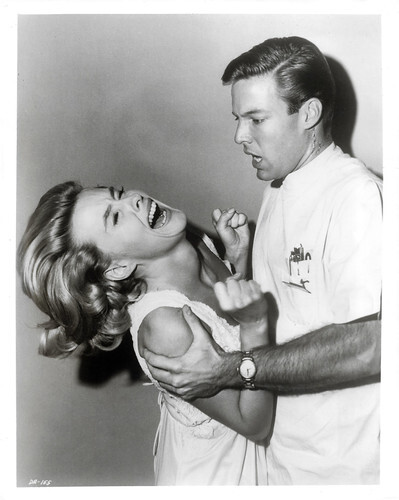
American press photo by Helen Ferguson Public Relations, El Camino / Beverly Hills, no. DR 155. Photo: MGM-TV. Dina Merrill and Richard Chamberlain in the episode Oh, My Daughter (Buzz Kulik, 1962) of the TV series Dr. Kildare (1961-1966).
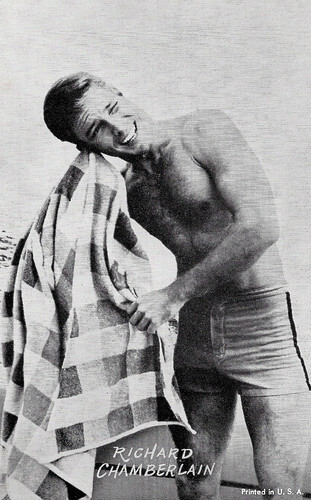
American Arcade card.
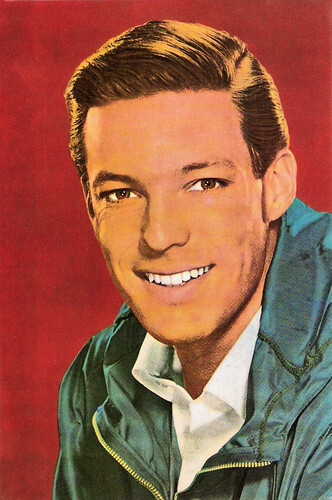
Spanish postcard by Postalcolor, Hospitalet (Barcelona), no. 55, 1964.
Sources: (IMDb), Wikipedia and .

German postcard by Krüger, no. 902/240.

Spanish postcard by Archivo Bermejo, no. C. 174, 1964. Richard Chamberlain in the TV series Dr. Kildare (1961-1966).

Vintage Spanish photo. Glenda Jackson and Richard Chamberlain in The Music Lovers (Ken Russell, 1971), a biopic on composer Pyotr Ilyich Tchaikovsky.

British postcard Gerimp Corp. Int.-Collection, no. FN 147. Richard Chamberlain in Shōgun (1980).
The leading heartthrob of early 1960s television
George Richard Chamberlain was born in 1934 in Beverly Hills, Los Angeles. He was the second son of Elsa Winnifred (von Benzon) and Charles Axiom Chamberlain, who was a salesman. He had a profoundly unhappy childhood and did not enjoy school, making up for it somewhat by excelling in track and developing a strong interest in acting. In 1952, Chamberlain graduated from Beverly Hills High School and in 1956, he graduated from Pomona College in Claremont, California. In December 1956, he was drafted into the United States Army for 16 months, serving in Korea.
Soon after his discharge from the army, Chamberlain headed for Hollywood. In 1959, he co-founded the theatre company the Company of Angels (CoA), now the oldest not-for-profit repertory theatre in Los Angeles. In just a couple of years, Chamberlain worked up a decent resumé with several visible guest spots on such popular series as Alfred Hitchcock Presents (1959), Gunsmoke (1960) and Mr. Lucky (1960). As the star of the medical series Dr. Kildare (1961-1966), he became the leading heartthrob of early 1960s television. As the impeccably handsome Dr. James Kildare, the slim, butter-haired hunk with the near-perfect Ivy-League charm and smooth, intelligent demeanour, had the distaff fans fawning unwavering over him through the series' run.
While this would appear to be a dream situation for any new star, it brought Chamberlain a significant, unsettling identity crisis. More interested in a reputation as a serious actor, Chamberlain took a considerable risk and turned his back on Hollywood, devoting himself to the stage. An important dramatic role opposite Julie Christie in Petulia (Richard Lester, 1968) led him to England. He played a recently divorced doctor who finds solace in the company of an unhappily married socialite.
In the 1970s, Chamberlain enjoyed success as a leading man in European films. He played composer Pyotr Ilyich Tchaikovsky in The Music Lovers (Ken Russell, 1970) opposite Glenda Jackson , Lord Byron alongside Sarah Miles in Lady Caroline Lamb (Robert Bolt, 1972), and Aramis in The Three Musketeers (Richard Lester, 1973) with Michael York as D'Artagnan. The sequel, The Four Musketeers (Richard Lester, 1974), was released the following year.
Then he was the villain in the disaster film The Towering Inferno (John Guillermin, 1974) opposite Steve McQueen and Paul Newman , and Edmond Dantes in The Count of Monte Cristo (David Greene, 1975). In The Slipper and the Rose (Bryan Forbes, 1976), a musical version of the Cinderella story, co-starring Gemma Craven as Cinderella, he displayed his vocal talents as the Prince. In 1977, he earned cult status for the Australian thriller The Last Wave (Peter Weir, 1977). He played a Sydney lawyer who defends five Aboriginal Persons in a ritualised taboo murder and in the process learns disturbing things about himself and premonitions.

British postcard in the Star Pics series, no. SP459.

American Arcade card.

French postcard by Editions P.I., no. S-1679.
Outed at the age of 55
Since then, Richard Chamberlain has appeared in several miniseries such as Shōgun (Jerry London, 1980) opposite Toshirô Mifune and The Thorn Birds (Daryl Duke, 1983). He was the first to play Jason Bourne in the miniseries The Bourne Identity Roger Young, (1988). It earned him the title 'King of the Miniseries'.
He also performed classical stage roles and worked in the musical theatre. He was awarded the 1973 Los Angeles Drama Critics Circle Award for Distinguished Performance for his role as Cyrano in 'Cyrano de Bergerac' (1973). On stage, he was also Henry Higgins in 'My Fair Lady' (1993-1994), Captain Von Trapp in 'The Sound of Music' (1999) and Ebenezer Scrooge in 'Scrooge: The Musical' (2005).
Chamberlain was romantically involved with television actor Wesley Eure in the early 1970s. In 1977, he met actor-writer-producer Martin Rabbett, with whom he began a long-term relationship. This led to a civil union in Hawaii, where the couple resided from 1986 to 2010 when Chamberlain legally adopted Rabbett to protect his future estate. Rabbett and Chamberlain starred together in, among others, Allan Quatermain and the Lost City of Gold (Gary Nelson, 1986), in which they played brothers Allan and Robeson Quatermain.
Chamberlain was outed, at the age of 55, by the French women's magazine Nous Deux in December 1989, but it was not until 2003 that he confirmed his homosexuality, in his autobiography, 'Shattered Love'. Gary Brumburgh at IMDb : "Married now to his longtime partner of over 40 years, writer/producer Martin Rabbett, he has accepted himself and shown to be quite a good sport in the process, appearing as gay characters in the film I Now Pronounce You Chuck & Larry (Dennis Dugan, 2007), and in TV episodes of Will & Grace (1998), Desperate Housewives (2004) and Brothers & Sisters (2006)."
In the spring of 2010, Richard Chamberlain returned to Los Angeles to pursue career opportunities, leaving Rabbett in Hawaii. Recently, Richard Chamberlain could be seen in the films, Nightmare Cinema (Joe Dante, 2018) and Finding Julia (Igor Sunara, 2019) and in an episode of the TV series Twin Peaks (David Lynch, 2017) starring Kyle MacLachlan. Chamberlain died of complications from a stroke in Waimānalo, Hawaii, on 29 March 2025 at the age of 90.

Spanish postcard by Postal Oscarcolor S.A., Hospitalet (Barcelona), no. 37.

American press photo by Helen Ferguson Public Relations, El Camino / Beverly Hills, no. DR 155. Photo: MGM-TV. Dina Merrill and Richard Chamberlain in the episode Oh, My Daughter (Buzz Kulik, 1962) of the TV series Dr. Kildare (1961-1966).

American Arcade card.

Spanish postcard by Postalcolor, Hospitalet (Barcelona), no. 55, 1964.
Sources: (IMDb), Wikipedia and .
Published on March 31, 2025 22:00
Rudy Hirigoyen
Rudy Hirigoyen (1919-2000) was a handsome French, Bask tenor, who was a famous Operetta singer in the 1940s and 1950s and a competitor of Luis Mariano. He starred in three French films, the musical comedy Musique en tête (1951), and the comedies Le collège en folie (1954) and L'auberge en folie (1956).
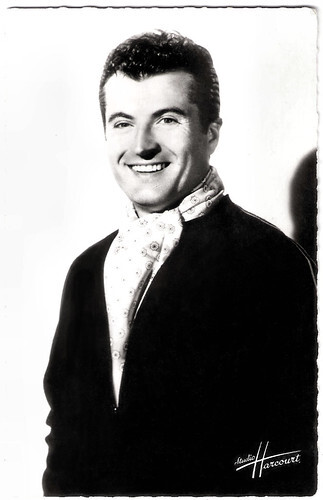
French postcard by Editions du Globe, Paris, no. 209. Photo: Studio Harcourt.
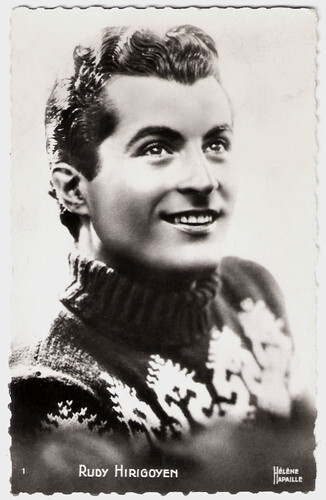
French postcard by Editions P.I., Paris, no. 1. Photo: Hélène Hapaille.
A miracle happened
Rudy Hirigoyen was born Émile Jean Baptiste Hirigoyen in 1919 in Mendionde in the heart of the French Pyrenees, in the Basque Country. Hirigoyen followed his parents to Paris in 1927. His family was of modest means, and he worked from an early age. He began his career as a hunter at the Hotel Georges V, then worked as a hairdresser for four years.
In his spare time, he sang for pleasure. Rudy was a dashing young man, small but robust, with a bright smile. Without any musical training, he won two radio talent shows in 1938. The following year, he came first in the Opéra and Opéra-Comique competitions with an aria from Giacomo Puccini's 'La Bohème', 'Que cette main est froide', ahead of 110 competitors. This success encouraged him to say goodbye to hairbrushes and curlers and to embark on a singing career.
He entered the Paris Conservatoire but was mobilised in 1939, taken prisoner and released in 1941. He was hired as a chorister at the Théâtre du Châtelet and as Maurice Vidal's ‘triplure’. A miracle happened: he sang Johann Strauss's 'Valses de Vienne' several times in 1941 and soon made a name for himself as a soloist. He was noticed by Henri Varna, who offered him a role in a tableau in one of his revues at the Casino de Paris. In 1944, he had his first successes: 'Ma belle au bois dormant', 'Au jardin de mon cœur', and 'Pastourelle à Nina'. Varna engaged him for the ‘verse comedy’ 'La Concierge est dans l'escalier' (1946) at the Palace, where he was the partner of Jane Sourza and Raymond Souplex .
As an Operetta singer, he was facing stiff competition from Luis Mariano . In 1947, Rudy took over from Mariano and performed Francis Lopez's 'La Belle de Cadix', first at the Casino-Montparnasse and then in the provinces. Rudy was later often Mariano's unofficial replacement, notably in 'Andalousie' (1954), 'Le Chanteur de Mexico' and 'Le Secret de Marco-Polo'. Rudy Hirigoyen reached his zenith in 1949 when he performed the first post-war Parisian revival of Franz Lehár's masterpiece, the operetta 'Le Pays du sourire' at the Gaîté-Lyrique.
With elegance and a rare warmth, the young singer proved himself a worthy successor to his elders, Louis Izar, Willy Thunis and José Janson. His tenor voice rose to the top with great ease, and he could hold it for a long time. This lightness combined with suppleness compensated for a lack of power in his delivery (light voices are rarely powerful) and allowed the singer never to be ‘shrill’.
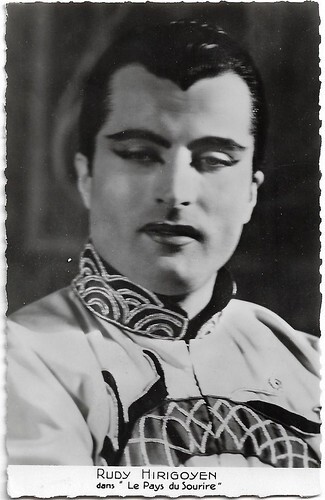
French postcard by Editions P.I., Paris. Rudy Hirigoyen in 'Le Pays du Sourire', the French version of the operetta 'Das Land des Lächelns' by Franz Lehár. It was performed in 1949 at the Paris' Gaité Lyrique.
Lacking a big hit
During the 1950s, Rudy Hirigoyen went on to recreate the such operettas as 'Le Brigand d'amour' (1951), 'Les Caprices de Vichnou (1951) at the Théâtre de l'Étoile and also created new works like 'Pour toi' (music by Georges Dherain), and 'Maria-Flora' (music by Henri Betti, 1957).
He also acted in three films. The first was the musical comedy Musique en tête / Music on Your Mind (Georges Combret, Claude Orval, 1951) with Jacques Hélian and his orchestra. Three years later followed the comedy Le collège en folie / College on the Run (Henri Lepage, 1954) in which he had the lead opposite Nicole Courcel . His third and last film was the sequel, L'auberge en folie / The Crazy Hostel (Pierre Chevalier, 1956), again with Hirigoyen in the lead and now with Geneviève Kervine as his co-star.
In 1959, Francis Lopez wrote his first operetta, especially for the tenor: in 'Viva Napoli!', Rudy played a very credible Bonaparte. Viva Napoli! was performed 100 times by its creator the following year at the Théâtre Mogador. After that, productions with Hirigoyen in the French capital were few and far between. He appeared on stage in 'Méditerranée' (1964) at the Théâtre du Châtelet, and again in 'Viva Napoli' (music by Francis Lopez, 1970) at the Mogador.
Until 1987, he toured France, Belgium, Switzerland, Canada and North Africa performing works by Francis Lopez including 'La Toison d'Or', 'La Route fleurie', 'Le Prince de Madrid', and 'Gipsy'. His last creation was an operetta by Francis Lopez, 'Fandango', presented in 1987 at the Élysée-Montmartre. What Rudy Hirigoyen seems to have lacked to have the same reputation as Luis Mariano , Georges Guétary or André Dassary , is a big hit to which his name could have been attached. He made some fine creations, but not a ‘hit’.
In the 1980s, he gave singing lessons at the Cité des Artistes in Paris. Later he moved to Lyon. As the honorary president of the Friends of the Lyon Operetta Theatre, he supported the continued existence of the art of Operetta. Rudy Hirigoyen died in 2000 in Lyon, at the age of 81. He was married to Christiane Lamielle (1954-1969; divorce), Denise Bienvenu (1975-?) and Sylviane Ohanessian (1996-2000; his death). He had a daughter, Valérie. After his death, the 'Association des Amis de Rudy Hirigoyen' was set up to publish his memoirs: 'Ma vie d'opérette'.
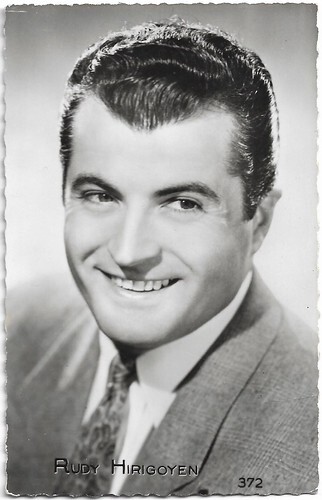
French postcard, offered by Les Carbones Korès, 'Carboplane', no. 372.
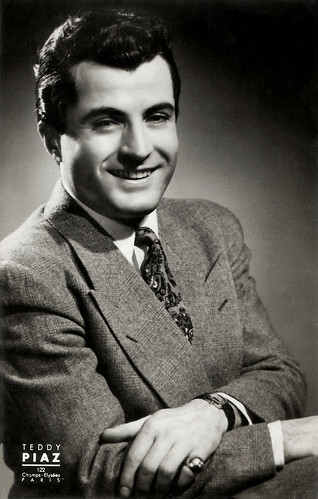
French postcard by Editions O.P., Paris, no. 29. Photo: Teddy Piaz.
Sources: Jean-Claude Fournier (Théâtre Musical - Opérette - French), Wikipedia (French) and .

French postcard by Editions du Globe, Paris, no. 209. Photo: Studio Harcourt.

French postcard by Editions P.I., Paris, no. 1. Photo: Hélène Hapaille.
A miracle happened
Rudy Hirigoyen was born Émile Jean Baptiste Hirigoyen in 1919 in Mendionde in the heart of the French Pyrenees, in the Basque Country. Hirigoyen followed his parents to Paris in 1927. His family was of modest means, and he worked from an early age. He began his career as a hunter at the Hotel Georges V, then worked as a hairdresser for four years.
In his spare time, he sang for pleasure. Rudy was a dashing young man, small but robust, with a bright smile. Without any musical training, he won two radio talent shows in 1938. The following year, he came first in the Opéra and Opéra-Comique competitions with an aria from Giacomo Puccini's 'La Bohème', 'Que cette main est froide', ahead of 110 competitors. This success encouraged him to say goodbye to hairbrushes and curlers and to embark on a singing career.
He entered the Paris Conservatoire but was mobilised in 1939, taken prisoner and released in 1941. He was hired as a chorister at the Théâtre du Châtelet and as Maurice Vidal's ‘triplure’. A miracle happened: he sang Johann Strauss's 'Valses de Vienne' several times in 1941 and soon made a name for himself as a soloist. He was noticed by Henri Varna, who offered him a role in a tableau in one of his revues at the Casino de Paris. In 1944, he had his first successes: 'Ma belle au bois dormant', 'Au jardin de mon cœur', and 'Pastourelle à Nina'. Varna engaged him for the ‘verse comedy’ 'La Concierge est dans l'escalier' (1946) at the Palace, where he was the partner of Jane Sourza and Raymond Souplex .
As an Operetta singer, he was facing stiff competition from Luis Mariano . In 1947, Rudy took over from Mariano and performed Francis Lopez's 'La Belle de Cadix', first at the Casino-Montparnasse and then in the provinces. Rudy was later often Mariano's unofficial replacement, notably in 'Andalousie' (1954), 'Le Chanteur de Mexico' and 'Le Secret de Marco-Polo'. Rudy Hirigoyen reached his zenith in 1949 when he performed the first post-war Parisian revival of Franz Lehár's masterpiece, the operetta 'Le Pays du sourire' at the Gaîté-Lyrique.
With elegance and a rare warmth, the young singer proved himself a worthy successor to his elders, Louis Izar, Willy Thunis and José Janson. His tenor voice rose to the top with great ease, and he could hold it for a long time. This lightness combined with suppleness compensated for a lack of power in his delivery (light voices are rarely powerful) and allowed the singer never to be ‘shrill’.

French postcard by Editions P.I., Paris. Rudy Hirigoyen in 'Le Pays du Sourire', the French version of the operetta 'Das Land des Lächelns' by Franz Lehár. It was performed in 1949 at the Paris' Gaité Lyrique.
Lacking a big hit
During the 1950s, Rudy Hirigoyen went on to recreate the such operettas as 'Le Brigand d'amour' (1951), 'Les Caprices de Vichnou (1951) at the Théâtre de l'Étoile and also created new works like 'Pour toi' (music by Georges Dherain), and 'Maria-Flora' (music by Henri Betti, 1957).
He also acted in three films. The first was the musical comedy Musique en tête / Music on Your Mind (Georges Combret, Claude Orval, 1951) with Jacques Hélian and his orchestra. Three years later followed the comedy Le collège en folie / College on the Run (Henri Lepage, 1954) in which he had the lead opposite Nicole Courcel . His third and last film was the sequel, L'auberge en folie / The Crazy Hostel (Pierre Chevalier, 1956), again with Hirigoyen in the lead and now with Geneviève Kervine as his co-star.
In 1959, Francis Lopez wrote his first operetta, especially for the tenor: in 'Viva Napoli!', Rudy played a very credible Bonaparte. Viva Napoli! was performed 100 times by its creator the following year at the Théâtre Mogador. After that, productions with Hirigoyen in the French capital were few and far between. He appeared on stage in 'Méditerranée' (1964) at the Théâtre du Châtelet, and again in 'Viva Napoli' (music by Francis Lopez, 1970) at the Mogador.
Until 1987, he toured France, Belgium, Switzerland, Canada and North Africa performing works by Francis Lopez including 'La Toison d'Or', 'La Route fleurie', 'Le Prince de Madrid', and 'Gipsy'. His last creation was an operetta by Francis Lopez, 'Fandango', presented in 1987 at the Élysée-Montmartre. What Rudy Hirigoyen seems to have lacked to have the same reputation as Luis Mariano , Georges Guétary or André Dassary , is a big hit to which his name could have been attached. He made some fine creations, but not a ‘hit’.
In the 1980s, he gave singing lessons at the Cité des Artistes in Paris. Later he moved to Lyon. As the honorary president of the Friends of the Lyon Operetta Theatre, he supported the continued existence of the art of Operetta. Rudy Hirigoyen died in 2000 in Lyon, at the age of 81. He was married to Christiane Lamielle (1954-1969; divorce), Denise Bienvenu (1975-?) and Sylviane Ohanessian (1996-2000; his death). He had a daughter, Valérie. After his death, the 'Association des Amis de Rudy Hirigoyen' was set up to publish his memoirs: 'Ma vie d'opérette'.

French postcard, offered by Les Carbones Korès, 'Carboplane', no. 372.

French postcard by Editions O.P., Paris, no. 29. Photo: Teddy Piaz.
Sources: Jean-Claude Fournier (Théâtre Musical - Opérette - French), Wikipedia (French) and .
Published on March 31, 2025 00:00
March 29, 2025
Sparrows (1926)
Sparrows (William Beaudine, 1926) is one of Mary Pickford's most unexpected films and her only Gothic melodrama. As Molly, the eldest child at a baby farm hidden deep in a swamp, she must rescue the others when their cruel master decides that one of them will be disposed of. Pickford, who was the most powerful woman in Hollywood at the time, also produced the film. It was the last time she portrayed a child.
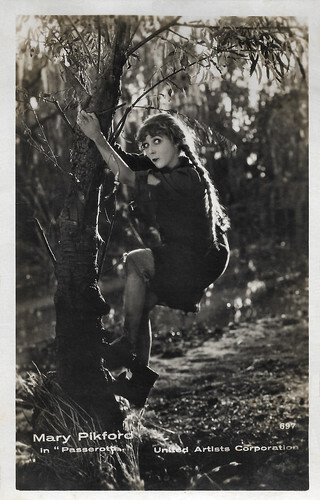
Italian postcard by Ed. Vettori, Bologna, no. 697. Photo: United Artists. Mary Pickford in Sparrows (William Beaudine, 1926). The Italian release title was Passerotti.
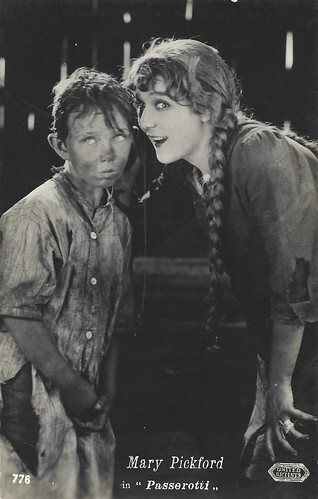
Italian postcard by Ballerini & Fratini, Firenze, no. 776. Photo: United Artists. Monty O'Grady and Mary Pickford in Sparrows (William Beaudine, 1926). The Italian release title was Passerotti.
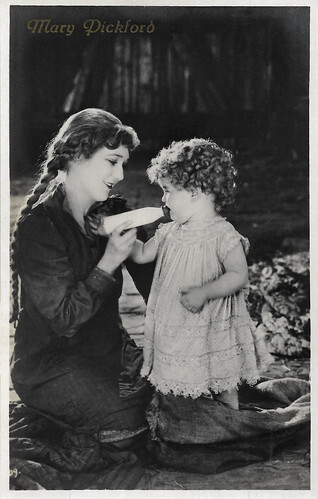
Italian postcard by G.B. Falci Editore, Milano, no. 497. Mary Pickford and Mary Louise Miller in Sparrows (William Beaudine, 1926).
A horror baby farm
Sparrows (1926) is situated in the American South where the mean Mr Grimes (Gustav von Seyffertitz) runs a farm with his wife (Charlotte Mineau) and their mentally retarded son Ambrose (Spec O'Donnell), surrounded by barely accessible swamps and alligators. The Grimes family admits abandoned children and babies - mainly orphans - so they can work on their land. The children have hard working hours and are mistreated, almost starved, and practically kept in prison by their wicked guardians. They have to hide when strangers turn up to conceal these conditions from the outside world.
The eldest orphan, Molly ( Mary Pickford ), mainly looks after the small children and occasionally steals food for them. She is motivated by charity and her faith in God, which she also tries to pass on to the boys and girls. God, says Molly, would watch over everyone here and protect them just as he does for the sparrows... When a cattle dealer appears on the farm one day, Ambrose Grimes sells him one of the children for profit: Splutters, the little ‘stutterer’. Meanwhile, Molly keeps the increasingly desperate children happy by repeating the Bible quote about God's sparrows so that the little ones never completely lose hope.
Ambrose catches Molly embezzling potatoes because the children are starving. Despite Molly's insistent pleas, old Grimes makes all the children suffer and tortures them even more cruelly. The youngest of the children is already so ill that he dies the next night in the face of this latest affliction. Like a vision, Jesus Christ enters the barn and takes the baby to himself. When Molly wakes up, the little one is dead.
The Grimes clan is becoming increasingly brutal and ruthless. They kidnap the infant Doris Wayne (Mary Louise Miller) to extort a ransom from her father, a millionaire. Molly is overjoyed with the new baby. When Mr Grimes reads about the kidnapping in the newspaper a few days later, he tells his son to throw the baby into the swamp so as not to lead the police onto Grimes' trail. At the last moment, the courageous Molly can prevent this crime and takes Doris. The young woman realises that she and her ‘sparrows of God’ must finally stand up to their murderous tormentors. First, she tries to fend off the Grimes threat with a pitchfork. Then they all finally dare to escape. The little trek of minors sets off to cross the dangerous swamp, where hungry alligators are just waiting for fresh meat. Grimes is not worried about this; he firmly believes that either the swamp or the alligators will do the dirty work for him and devour the fugitives. In fact, all the children escape unharmed and hide in a motorboat that belongs to the kidnappers.
Splutters, the ‘stutterer’ (Monty O'Grady) has escaped from his ‘buyer’ and is recognised as one of the missing children. He tells the Police about Mr Grimes' horror farm and his family. Mr Wayne (Roy Stewart) is also present and hopes to get his little daughter back soon. Finally, the police set out to carry out a large-scale raid in the swamps. Molly's hiding place in the boat proves to be too dangerous. Old Grimes is chased by the police during the raid, flees into the marshes and sinks there. Mrs Grimes and her wayward son reach the motorboat where Molly and her ‘sparrows’ had just been and flee. As they are unable to shake off a police boat patrol, they switch to a more manoeuvrable rubber dinghy, but are immediately run over by the police boat and also die in the muddy water. Molly and the others, including the kidnapped Wayne baby Doris, are rescued, and as an act of gratitude, the rich Mr Wayne promises to look after all the rescued children from now on.
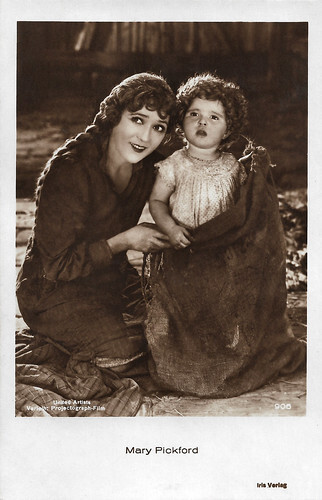
Austrian postcard by Iris Verlag, no. 906. Photo: United Artists / Projectograph-Film. Mary Pickford and Mary Louise Miller in Sparrows (William Beaudine, 1926).
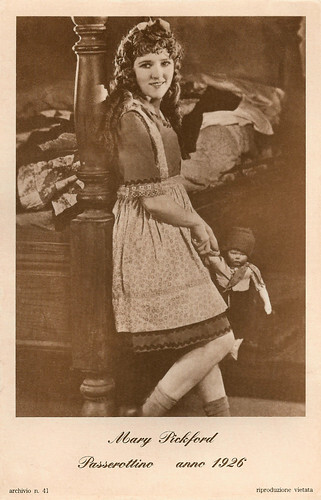
Italian postcard in the Archivio series by Diesse F. Lli de Siena / S. Girogrio A. Cremano, Napoli, no. 41. Mary Pickford in Sparrows (William Beaudine, 1926), The Italian title was Passerotti.
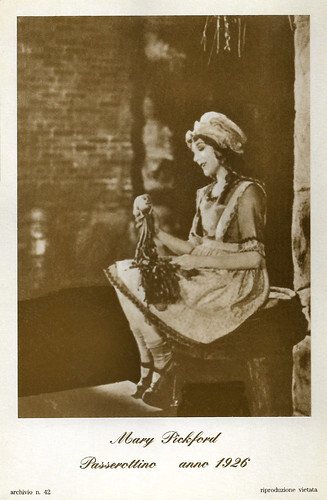
Italian postcard in the Archivio series by Diesse F. Lli de Siena / S. Girogrio A. Cremano, Napoli, no. 42. Mary Pickford in Sparrows (William Beaudine, 1926). The Italian title was Passerotti.
There wasn't an alligator within ten miles of Miss Pickford
According to a then-well-established theatrical and cinematic convention, the role of Molly was given to an adult actress, while child actors were given supporting parts. Mary Pickford , already 33 years old at the time of filming, had specialised during her career in such little girl parts, and Sparrows (1926) was the final one in a long successful row. Sparrows was Pickford's next-to-last silent role, followed by My Best Girl (1927) in which she played a young woman of indeterminate age. After that, Pickford made some talking pictures before retiring to Pickfair, her estate, with her husband Douglas Fairbanks .
Sparrows was produced by the Pickford Corporation with an estimated budget of $463,455 and shot in July 1925 in West Hollywood. It was directed by William Beaudine and (uncredited) Tom McNamara. Winifred Dunn wrote the story. Art director Harry Oliver designed the magnificent film set. He went to great lengths to transform 4 acres (16,000 m2) of the back lot between Willoughby Avenue and Alta Vista Street into a stylized Gothic swamp. The ground was scraped bare in places, 600 trees were transplanted, and pits were dug and filled with a mixture of burned cork, sawdust and muddy water.
Sparrows is a full-blooded Gothic melodrama. The subject matter is dark, and some of the horrors are reminiscent of Charles Dickens , but the darkness is interspersed with plenty of laughs. Mary Pickford plays naturally and her little co-stars are of unprecedented ease. The film also presents Gustav von Seyffertitz with the best role of his career. Distributed by United Artists, the film premiered in Hollywood on 14 May 1926 and in New York on 19 September. Some critics expected that Sparrows would be too strong for audiences, but it did well. In the United States, the film grossed $966,878. In later years, Pickford repeatedly recounted the story that she was concerned that director William Beaudine was jeopardizing the actors, particularly when he insisted she carry a real baby, rather than a doll as she wanted, across some water teeming with alligators (albeit with their jaws bound shut). However, Hal Mohr, the film's director of photography, debunked this tale, saying "There wasn't an alligator within ten miles of Miss Pickford," and revealing in precise detail how the effect was done.
An incomplete six-reel copy of the film - a 35 mm nitrate tinted positive - is preserved in the archives of the Library of Congress (American Film Institute / Mary Pickford collection). A 35 mm positive is in the archives of the Cinémathèque Française; negatives and positives are in those of the Mary Pickford Institute for Film Education film collection. The film was presented in 2008 at the Giornate del Cinema Muto (the Pordenone Silent Film Festival) in Italy.
Film historian Jeffrey Vance considers Sparrows to be Pickford's masterpiece. In his program notes for the Giornate del Cinema Muto, Vance wrote: "Sparrows is her most fully realized and timeless work of art. The film’s superb performances, gothic production design, and cinematography all serve a suspenseful, emotionally compelling story anchored by a central performance by Pickford herself imbued with pathos, humour, and charm." In 2012, Milestone Film & Video released the Library of Congress restoration of Sparrows to DVD and Blu-ray, as part of the box set 'Rags and Riches: Mary Pickford Collection". It contains an audio commentary track by Jeffrey Vance and Tony Maietta.
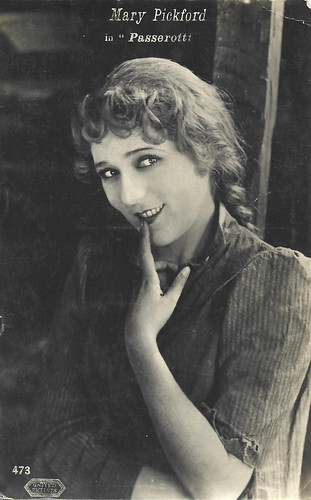
Italian postcard by Edit. B.F.F. (Ballerini & Fratini, Firenze), no. 473. Photo: United Artists. Mary Pickford in Sparrows (William Beaudine, 1926). The Italian release title was Passerotti.
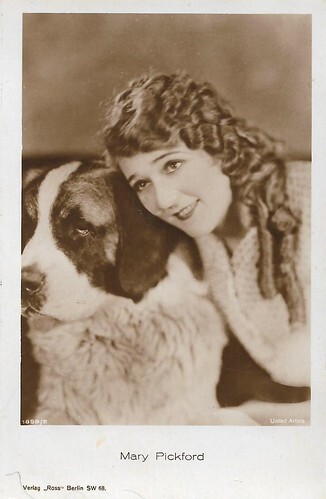
German postcard by Ross Verlag, no. 1852/2, 1927-1928. Photo: United Artists.
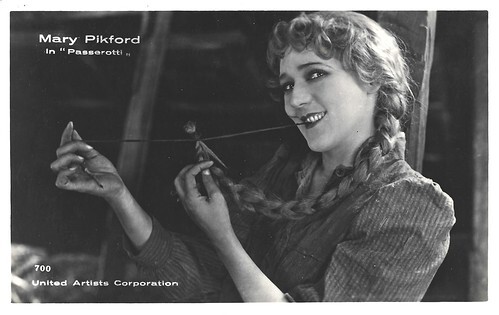
Italian postcard by Ed. Vettori, Bologna, no. 700. Photo: United Artists. Mary Pickford in Sparrows (William Beaudine, 1926). The Italian release title was Passerotti.
Sources: Wikipedia (Dutch, French, German, Italian and English) and IMDb.

Italian postcard by Ed. Vettori, Bologna, no. 697. Photo: United Artists. Mary Pickford in Sparrows (William Beaudine, 1926). The Italian release title was Passerotti.

Italian postcard by Ballerini & Fratini, Firenze, no. 776. Photo: United Artists. Monty O'Grady and Mary Pickford in Sparrows (William Beaudine, 1926). The Italian release title was Passerotti.

Italian postcard by G.B. Falci Editore, Milano, no. 497. Mary Pickford and Mary Louise Miller in Sparrows (William Beaudine, 1926).
A horror baby farm
Sparrows (1926) is situated in the American South where the mean Mr Grimes (Gustav von Seyffertitz) runs a farm with his wife (Charlotte Mineau) and their mentally retarded son Ambrose (Spec O'Donnell), surrounded by barely accessible swamps and alligators. The Grimes family admits abandoned children and babies - mainly orphans - so they can work on their land. The children have hard working hours and are mistreated, almost starved, and practically kept in prison by their wicked guardians. They have to hide when strangers turn up to conceal these conditions from the outside world.
The eldest orphan, Molly ( Mary Pickford ), mainly looks after the small children and occasionally steals food for them. She is motivated by charity and her faith in God, which she also tries to pass on to the boys and girls. God, says Molly, would watch over everyone here and protect them just as he does for the sparrows... When a cattle dealer appears on the farm one day, Ambrose Grimes sells him one of the children for profit: Splutters, the little ‘stutterer’. Meanwhile, Molly keeps the increasingly desperate children happy by repeating the Bible quote about God's sparrows so that the little ones never completely lose hope.
Ambrose catches Molly embezzling potatoes because the children are starving. Despite Molly's insistent pleas, old Grimes makes all the children suffer and tortures them even more cruelly. The youngest of the children is already so ill that he dies the next night in the face of this latest affliction. Like a vision, Jesus Christ enters the barn and takes the baby to himself. When Molly wakes up, the little one is dead.
The Grimes clan is becoming increasingly brutal and ruthless. They kidnap the infant Doris Wayne (Mary Louise Miller) to extort a ransom from her father, a millionaire. Molly is overjoyed with the new baby. When Mr Grimes reads about the kidnapping in the newspaper a few days later, he tells his son to throw the baby into the swamp so as not to lead the police onto Grimes' trail. At the last moment, the courageous Molly can prevent this crime and takes Doris. The young woman realises that she and her ‘sparrows of God’ must finally stand up to their murderous tormentors. First, she tries to fend off the Grimes threat with a pitchfork. Then they all finally dare to escape. The little trek of minors sets off to cross the dangerous swamp, where hungry alligators are just waiting for fresh meat. Grimes is not worried about this; he firmly believes that either the swamp or the alligators will do the dirty work for him and devour the fugitives. In fact, all the children escape unharmed and hide in a motorboat that belongs to the kidnappers.
Splutters, the ‘stutterer’ (Monty O'Grady) has escaped from his ‘buyer’ and is recognised as one of the missing children. He tells the Police about Mr Grimes' horror farm and his family. Mr Wayne (Roy Stewart) is also present and hopes to get his little daughter back soon. Finally, the police set out to carry out a large-scale raid in the swamps. Molly's hiding place in the boat proves to be too dangerous. Old Grimes is chased by the police during the raid, flees into the marshes and sinks there. Mrs Grimes and her wayward son reach the motorboat where Molly and her ‘sparrows’ had just been and flee. As they are unable to shake off a police boat patrol, they switch to a more manoeuvrable rubber dinghy, but are immediately run over by the police boat and also die in the muddy water. Molly and the others, including the kidnapped Wayne baby Doris, are rescued, and as an act of gratitude, the rich Mr Wayne promises to look after all the rescued children from now on.

Austrian postcard by Iris Verlag, no. 906. Photo: United Artists / Projectograph-Film. Mary Pickford and Mary Louise Miller in Sparrows (William Beaudine, 1926).

Italian postcard in the Archivio series by Diesse F. Lli de Siena / S. Girogrio A. Cremano, Napoli, no. 41. Mary Pickford in Sparrows (William Beaudine, 1926), The Italian title was Passerotti.

Italian postcard in the Archivio series by Diesse F. Lli de Siena / S. Girogrio A. Cremano, Napoli, no. 42. Mary Pickford in Sparrows (William Beaudine, 1926). The Italian title was Passerotti.
There wasn't an alligator within ten miles of Miss Pickford
According to a then-well-established theatrical and cinematic convention, the role of Molly was given to an adult actress, while child actors were given supporting parts. Mary Pickford , already 33 years old at the time of filming, had specialised during her career in such little girl parts, and Sparrows (1926) was the final one in a long successful row. Sparrows was Pickford's next-to-last silent role, followed by My Best Girl (1927) in which she played a young woman of indeterminate age. After that, Pickford made some talking pictures before retiring to Pickfair, her estate, with her husband Douglas Fairbanks .
Sparrows was produced by the Pickford Corporation with an estimated budget of $463,455 and shot in July 1925 in West Hollywood. It was directed by William Beaudine and (uncredited) Tom McNamara. Winifred Dunn wrote the story. Art director Harry Oliver designed the magnificent film set. He went to great lengths to transform 4 acres (16,000 m2) of the back lot between Willoughby Avenue and Alta Vista Street into a stylized Gothic swamp. The ground was scraped bare in places, 600 trees were transplanted, and pits were dug and filled with a mixture of burned cork, sawdust and muddy water.
Sparrows is a full-blooded Gothic melodrama. The subject matter is dark, and some of the horrors are reminiscent of Charles Dickens , but the darkness is interspersed with plenty of laughs. Mary Pickford plays naturally and her little co-stars are of unprecedented ease. The film also presents Gustav von Seyffertitz with the best role of his career. Distributed by United Artists, the film premiered in Hollywood on 14 May 1926 and in New York on 19 September. Some critics expected that Sparrows would be too strong for audiences, but it did well. In the United States, the film grossed $966,878. In later years, Pickford repeatedly recounted the story that she was concerned that director William Beaudine was jeopardizing the actors, particularly when he insisted she carry a real baby, rather than a doll as she wanted, across some water teeming with alligators (albeit with their jaws bound shut). However, Hal Mohr, the film's director of photography, debunked this tale, saying "There wasn't an alligator within ten miles of Miss Pickford," and revealing in precise detail how the effect was done.
An incomplete six-reel copy of the film - a 35 mm nitrate tinted positive - is preserved in the archives of the Library of Congress (American Film Institute / Mary Pickford collection). A 35 mm positive is in the archives of the Cinémathèque Française; negatives and positives are in those of the Mary Pickford Institute for Film Education film collection. The film was presented in 2008 at the Giornate del Cinema Muto (the Pordenone Silent Film Festival) in Italy.
Film historian Jeffrey Vance considers Sparrows to be Pickford's masterpiece. In his program notes for the Giornate del Cinema Muto, Vance wrote: "Sparrows is her most fully realized and timeless work of art. The film’s superb performances, gothic production design, and cinematography all serve a suspenseful, emotionally compelling story anchored by a central performance by Pickford herself imbued with pathos, humour, and charm." In 2012, Milestone Film & Video released the Library of Congress restoration of Sparrows to DVD and Blu-ray, as part of the box set 'Rags and Riches: Mary Pickford Collection". It contains an audio commentary track by Jeffrey Vance and Tony Maietta.

Italian postcard by Edit. B.F.F. (Ballerini & Fratini, Firenze), no. 473. Photo: United Artists. Mary Pickford in Sparrows (William Beaudine, 1926). The Italian release title was Passerotti.

German postcard by Ross Verlag, no. 1852/2, 1927-1928. Photo: United Artists.

Italian postcard by Ed. Vettori, Bologna, no. 700. Photo: United Artists. Mary Pickford in Sparrows (William Beaudine, 1926). The Italian release title was Passerotti.
Sources: Wikipedia (Dutch, French, German, Italian and English) and IMDb.
Published on March 29, 2025 22:00
March 28, 2025
Hubert von Meyerinck
Complete with a waxed moustache and monocle, bald, straight-backed German actor Hubert von Meyerinck (1896-1971) looked every inch a poster boy for Prussian militarism. After his debut in Berlin in 1917, he became a prominent stage actor as Marlene Dietrich's partner in the 1927 revue 'Es liegt was in der Luft', as Mephisto in 'Faust' and as Mack the Knife in Brecht's 'Threepenny Opera'. From 1929, he appeared in 294 films, normally in supporting roles. Audiences loved him as oily swindlers, impoverished aristocrats out to marry for money, bigamists, effete movie folk or obtuse officials.
German collectors card by Ross Verlag in the series Vom Werden deutscher Filmkunst - Der Stumme Film, picture no. 64, group 43. Photo: Ufa. Georg Alexander , Harry Liedtke and Hubert von Meyerinck in Der Mann ohne Nahmen/The Man Without a Name (Georg Jacoby, 1921).
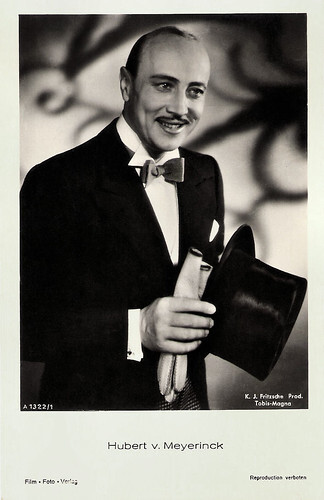
German postcard by Film-Foto-Verlag, no. A 1322/1, 1937-1938. Photo: K.J. Fritzsche Prod. / Tobis / Magna. Hubert von Meyerinck in Der Unwiderstehliche / The Irresistible Man (Géza von Bolváry, 1937).
Men with an airy-fairy demeanour who often turned out to be impostors or criminals
Hubert(us) Georg Werner Harald von Meyerinck was born in 1896 in Potsdam, Germany. He was the only son of Friedrich von Meyerinck, a Captain in the Prussian Army and landowner, and his first wife Caroline née von Hoppenstedt. The actress Gudrun Genest was his niece. As a young child, von Meyerinck already started taking acting lessons, much to the disdain of his parents who wanted him to become a priest.
After the divorce of his parents in 1909, he grew up with his mother on the family estate in Posen. He then attended a grammar school in Godesberg and was called up for military service during World War I. He served for a short time as an ensign in Karlsruhe but was discharged due to a lung disease that led to several stays in a sanatorium.
After acting lessons with Rudolf Lettinger, he made his theatre debut in 1917 at the Berliner Schauspielhaus as Leutnant von Hagen in Paul Heyse's 'Kolberg'. From 1918 to 1920, he had an engagement at the Hamburg Kammerspiele and then returned to Berlin, where he appeared successfully in Carl Sternheim's avant-garde plays. He appeared in various revues and cabarets, including the famous Tingeltangel. He later played at the Deutsches Theater, the Komödie am Kurfürstendamm (for example in the musical revue 'Es liegt was in der Luft' (There's Something in the Air) with Marlene Dietrich ) and the Lessingtheater in roles such as Mackie Messer (Mack the Knife) in Bertolt Brecht's 'Die Dreigroschenoper' (The Threepenny Opera), and as the title figure in Carl Zuckmayer's satire 'Der Hauptmann von Köpenick' (The Captain of Köpenick).
In 1920, von Meyerinck was discovered for silent film. Bald, with a moustache and often wearing a monocle, he became a well-known figure in German film. After his first significant role in the serial Der Mann ohne Namen/Peter Voss, Thief of Millions (Georg Jacoby, 1921), he played supporting roles in silent films like Manon Lescaut (Arthur Robison, 1926) starring Lya de Putti or Wilhelm Dieterle 's Ich lebe für Dich/Triumph of Love (1929). Initially, von Meyerinck emphasised the femininity of his appearance. In a Paul Wegener film, he danced on a table dressed in pink ballet flats, his mother's ermine cape and a blue silk cap as a headdress.
His distinctive homoerotic nuances were later used by his directors for negative characterisation. In the later emerging sound film, he brought his characteristic voice and rasping articulation to bear. He played men with an airy-fairy demeanour who often turned out to be impostors or criminals. Among his most popular works in the early sound days were Max Ophüls' Die verliebte Firma/The Company's in Love (1932), Wenn die Liebe Mode macht/When Love Sets the Fashion (Franz Wenzler, 1932) with Renate Müller and Der weiße Dämon/The White Demon (Kurt Gerron, 1932) starring Hans Albers , Gerda Maurus and Peter Lorre . He became the most popular film villain in German cinema.
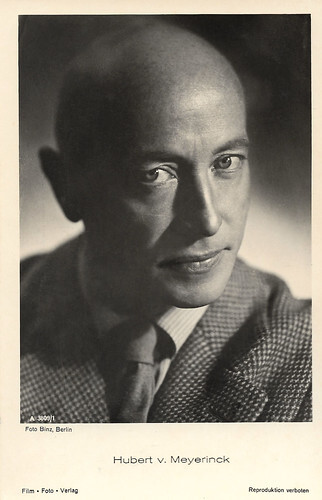
German postcard by Film-Foto-Verlag, no. A 3809/1, 1941-1944. Photo: Binz, Berlin.
Bizarre officials, aristocrats, generals and devious con artists
During the National Socialist era, Hubert von Meyerinck appeared in numerous films. Between 1933 and 1945, he appeared in over 90 productions, ranging from the comedy Ein falscher Fuffziger (1935) and Willi Forst 's adaptation of Guy de Maupassant's Bel Ami (1939) to Helmut Käutner's Kitty und die Weltkonferenz/Kitty and the World Conference (1939), starring Hannelore Schroth .
He also played smaller parts in propagandistic productions like Ein Volksfeind/An Enemy of the People (Hans Steinhoff, 1937) starring Heinrich George or Trenck, der Pandur/Trenck, Officer of the Pandurs (Herbert Selpin, 1940). In 1944, von Meyerinck was on the 'Gottbegnadeten-Liste' (the list of godsent) by the Reich Ministry for Popular Enlightenment and Propaganda. In the theatre, he was repeatedly seen in classical roles, for example as Mephisto in Goethe's 'Faust' or as Malvolio in William Shakespeare 's 'Twelfth Night'.
Although it was known that von Meyerinck was homosexual, he was not prosecuted by the Nazis. His friend and colleague Kurt von Ruffin, who was also homosexual, was imprisoned in a concentration camp for nine months. According to Von Ruffin, Von Meyerink did not exercise any great restraint about his orientation at the time and stood by friends who were at risk. The Jewish director Billy Wilder spoke about Meyernick in a 1997 interview with Der Spiegel: "I remember a gay actor, we called him Hubsi, Hubert von Meyerinck. He never vaunted himself for that, but during the Kristallnacht, he went along the Kurfürstendamm and called: 'If somebody among you is Jewish, follow me!' He cached the people in his apartment. Yes, there were decent people, whose words you could believe, that it was hard to do resistance during that time. People like Meyerinck were marvellous, wonderful." Von Meyerinck moved to Munich in 1950 but also performed at the theatres in Göttingen and Wuppertal. In 1966, he received a permanent engagement at the Thalia Theatre in Hamburg, where he gave his last performance as Agamemnon in 'Die schöne Helena' in 1971.
In the post-war cinema, he was cast in film comedies as bizarre officials, aristocrats, generals and devious con artists. In 1957 alone, "Hubsi" – as he was endearingly called by his fans – appeared in 13 films, including the box office hits Der tolle Blomberg/The Mad Bomberg (Rolf Thiele, 1957) and Das Wirtshaus im Spessart/The Spessart Inn (Kurt Hoffmann, 1957). One of von Meyerinck's most famous roles was in Billy Wilder 's classic comedy One, Two, Three (1961). There he played the impoverished yet pompous Count von Droste-Schattenburg, who worked as a toilet attendant and who adopted Horst Buchholz for financial reasons. Hubert von Meyerinck's last film successes were in the Edgar Wallace films Im Banne des Unheimlichen/The Zombie Walks (Alfred Vohrer, 1968) starring Joachim Fuchsberger , Der Gorilla von Soho/The Gorilla of Soho (Harald Philipp, 1968) with Horst Tappert, and Der Mann mit dem Glasauge/The Man With the Glass Eye (Alfred Vohrer, 1969), in which he played Sir Arthur, the quirky head of Scotland Yard. He appeared in a total of five Wallace films between 1965 and 1969.
By the end of his life, he had appeared in more than 275 films. Von Meyerinck knew how to shield his private life from the media. He was called ‘Hubsi’ or ‘Knurpsi’ by friends, family and colleagues. His memoirs were published in 1967 under the title 'Meine berühmten Freundinnen' (My Famous Girlfriends), in which he wrote about prominent colleagues like Marlene Dietrich and Adele Sandrock , but also about his beloved mother, with whom he had lived at Giesebrechtstraße 18 until her death. In 1971, Hubert von Meyerinck died of heart failure in Hamburg's Bethanien Hospital. He was 71. His grave is located in the Protestant cemetery in the parish of Schladen near Goslar. Berlin honoured him in August 1994 with the naming of Meyerinckplatz in Charlottenburg.
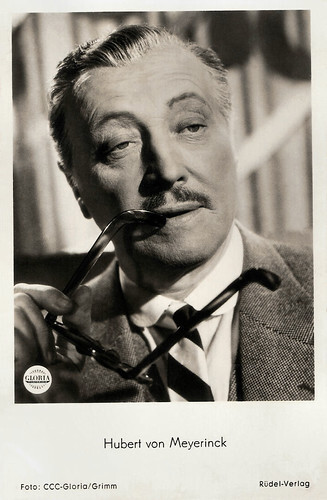
West German postcard by Rüdel-Verlag, Hamburg-Bergedorf, no. 1467. Photo: CCC / Gloria / Arthur Grimm. Hubert von Meyerinck in Liebe, Tanz und 1000 Schlager / Love, Dance, and 1000 Songs (Paul Martin, 1955).
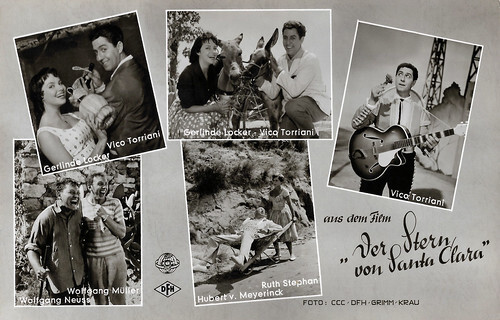
West German postcard by Rüdel-Verlag, Hamburg-Bergedorf. Photo: DFH / CCC / Arthur Grimm / Krau. Vico Torriani , Gerlinde Locker , Wolfgang Müller, Wolfgang Neuss, Hubert von Meyerinck and Ruth Stephan in Der Stern von Santa Clara / The Star of Santa Clara (Werner Jacobs, 1958).
Sources: (IMDb), Filmportal, Wikipedia (German and English) and .
German collectors card by Ross Verlag in the series Vom Werden deutscher Filmkunst - Der Stumme Film, picture no. 64, group 43. Photo: Ufa. Georg Alexander , Harry Liedtke and Hubert von Meyerinck in Der Mann ohne Nahmen/The Man Without a Name (Georg Jacoby, 1921).

German postcard by Film-Foto-Verlag, no. A 1322/1, 1937-1938. Photo: K.J. Fritzsche Prod. / Tobis / Magna. Hubert von Meyerinck in Der Unwiderstehliche / The Irresistible Man (Géza von Bolváry, 1937).
Men with an airy-fairy demeanour who often turned out to be impostors or criminals
Hubert(us) Georg Werner Harald von Meyerinck was born in 1896 in Potsdam, Germany. He was the only son of Friedrich von Meyerinck, a Captain in the Prussian Army and landowner, and his first wife Caroline née von Hoppenstedt. The actress Gudrun Genest was his niece. As a young child, von Meyerinck already started taking acting lessons, much to the disdain of his parents who wanted him to become a priest.
After the divorce of his parents in 1909, he grew up with his mother on the family estate in Posen. He then attended a grammar school in Godesberg and was called up for military service during World War I. He served for a short time as an ensign in Karlsruhe but was discharged due to a lung disease that led to several stays in a sanatorium.
After acting lessons with Rudolf Lettinger, he made his theatre debut in 1917 at the Berliner Schauspielhaus as Leutnant von Hagen in Paul Heyse's 'Kolberg'. From 1918 to 1920, he had an engagement at the Hamburg Kammerspiele and then returned to Berlin, where he appeared successfully in Carl Sternheim's avant-garde plays. He appeared in various revues and cabarets, including the famous Tingeltangel. He later played at the Deutsches Theater, the Komödie am Kurfürstendamm (for example in the musical revue 'Es liegt was in der Luft' (There's Something in the Air) with Marlene Dietrich ) and the Lessingtheater in roles such as Mackie Messer (Mack the Knife) in Bertolt Brecht's 'Die Dreigroschenoper' (The Threepenny Opera), and as the title figure in Carl Zuckmayer's satire 'Der Hauptmann von Köpenick' (The Captain of Köpenick).
In 1920, von Meyerinck was discovered for silent film. Bald, with a moustache and often wearing a monocle, he became a well-known figure in German film. After his first significant role in the serial Der Mann ohne Namen/Peter Voss, Thief of Millions (Georg Jacoby, 1921), he played supporting roles in silent films like Manon Lescaut (Arthur Robison, 1926) starring Lya de Putti or Wilhelm Dieterle 's Ich lebe für Dich/Triumph of Love (1929). Initially, von Meyerinck emphasised the femininity of his appearance. In a Paul Wegener film, he danced on a table dressed in pink ballet flats, his mother's ermine cape and a blue silk cap as a headdress.
His distinctive homoerotic nuances were later used by his directors for negative characterisation. In the later emerging sound film, he brought his characteristic voice and rasping articulation to bear. He played men with an airy-fairy demeanour who often turned out to be impostors or criminals. Among his most popular works in the early sound days were Max Ophüls' Die verliebte Firma/The Company's in Love (1932), Wenn die Liebe Mode macht/When Love Sets the Fashion (Franz Wenzler, 1932) with Renate Müller and Der weiße Dämon/The White Demon (Kurt Gerron, 1932) starring Hans Albers , Gerda Maurus and Peter Lorre . He became the most popular film villain in German cinema.

German postcard by Film-Foto-Verlag, no. A 3809/1, 1941-1944. Photo: Binz, Berlin.
Bizarre officials, aristocrats, generals and devious con artists
During the National Socialist era, Hubert von Meyerinck appeared in numerous films. Between 1933 and 1945, he appeared in over 90 productions, ranging from the comedy Ein falscher Fuffziger (1935) and Willi Forst 's adaptation of Guy de Maupassant's Bel Ami (1939) to Helmut Käutner's Kitty und die Weltkonferenz/Kitty and the World Conference (1939), starring Hannelore Schroth .
He also played smaller parts in propagandistic productions like Ein Volksfeind/An Enemy of the People (Hans Steinhoff, 1937) starring Heinrich George or Trenck, der Pandur/Trenck, Officer of the Pandurs (Herbert Selpin, 1940). In 1944, von Meyerinck was on the 'Gottbegnadeten-Liste' (the list of godsent) by the Reich Ministry for Popular Enlightenment and Propaganda. In the theatre, he was repeatedly seen in classical roles, for example as Mephisto in Goethe's 'Faust' or as Malvolio in William Shakespeare 's 'Twelfth Night'.
Although it was known that von Meyerinck was homosexual, he was not prosecuted by the Nazis. His friend and colleague Kurt von Ruffin, who was also homosexual, was imprisoned in a concentration camp for nine months. According to Von Ruffin, Von Meyerink did not exercise any great restraint about his orientation at the time and stood by friends who were at risk. The Jewish director Billy Wilder spoke about Meyernick in a 1997 interview with Der Spiegel: "I remember a gay actor, we called him Hubsi, Hubert von Meyerinck. He never vaunted himself for that, but during the Kristallnacht, he went along the Kurfürstendamm and called: 'If somebody among you is Jewish, follow me!' He cached the people in his apartment. Yes, there were decent people, whose words you could believe, that it was hard to do resistance during that time. People like Meyerinck were marvellous, wonderful." Von Meyerinck moved to Munich in 1950 but also performed at the theatres in Göttingen and Wuppertal. In 1966, he received a permanent engagement at the Thalia Theatre in Hamburg, where he gave his last performance as Agamemnon in 'Die schöne Helena' in 1971.
In the post-war cinema, he was cast in film comedies as bizarre officials, aristocrats, generals and devious con artists. In 1957 alone, "Hubsi" – as he was endearingly called by his fans – appeared in 13 films, including the box office hits Der tolle Blomberg/The Mad Bomberg (Rolf Thiele, 1957) and Das Wirtshaus im Spessart/The Spessart Inn (Kurt Hoffmann, 1957). One of von Meyerinck's most famous roles was in Billy Wilder 's classic comedy One, Two, Three (1961). There he played the impoverished yet pompous Count von Droste-Schattenburg, who worked as a toilet attendant and who adopted Horst Buchholz for financial reasons. Hubert von Meyerinck's last film successes were in the Edgar Wallace films Im Banne des Unheimlichen/The Zombie Walks (Alfred Vohrer, 1968) starring Joachim Fuchsberger , Der Gorilla von Soho/The Gorilla of Soho (Harald Philipp, 1968) with Horst Tappert, and Der Mann mit dem Glasauge/The Man With the Glass Eye (Alfred Vohrer, 1969), in which he played Sir Arthur, the quirky head of Scotland Yard. He appeared in a total of five Wallace films between 1965 and 1969.
By the end of his life, he had appeared in more than 275 films. Von Meyerinck knew how to shield his private life from the media. He was called ‘Hubsi’ or ‘Knurpsi’ by friends, family and colleagues. His memoirs were published in 1967 under the title 'Meine berühmten Freundinnen' (My Famous Girlfriends), in which he wrote about prominent colleagues like Marlene Dietrich and Adele Sandrock , but also about his beloved mother, with whom he had lived at Giesebrechtstraße 18 until her death. In 1971, Hubert von Meyerinck died of heart failure in Hamburg's Bethanien Hospital. He was 71. His grave is located in the Protestant cemetery in the parish of Schladen near Goslar. Berlin honoured him in August 1994 with the naming of Meyerinckplatz in Charlottenburg.

West German postcard by Rüdel-Verlag, Hamburg-Bergedorf, no. 1467. Photo: CCC / Gloria / Arthur Grimm. Hubert von Meyerinck in Liebe, Tanz und 1000 Schlager / Love, Dance, and 1000 Songs (Paul Martin, 1955).

West German postcard by Rüdel-Verlag, Hamburg-Bergedorf. Photo: DFH / CCC / Arthur Grimm / Krau. Vico Torriani , Gerlinde Locker , Wolfgang Müller, Wolfgang Neuss, Hubert von Meyerinck and Ruth Stephan in Der Stern von Santa Clara / The Star of Santa Clara (Werner Jacobs, 1958).
Sources: (IMDb), Filmportal, Wikipedia (German and English) and .
Published on March 28, 2025 23:00
March 27, 2025
La Collectionneuse: Louise Fazenda
From 1913 to 1939, Louise Fazenda was featured in about 260 shorts and features. She notably was one of Mack Sennett’s most famous comedy queens during the silent period. A devout Christian, she allegedly once said: "Someday when I’m through with pictures, I want to make a regular business of being friendly to people." And that’s exactly what she did!
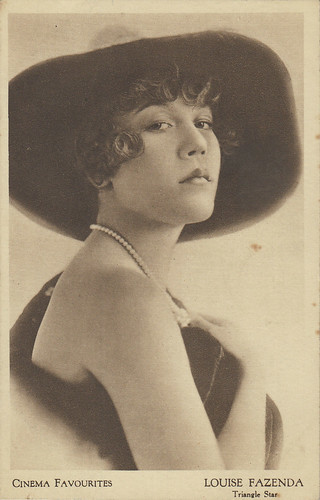
British postcard by Photochrom Co. Ltd., London no. 111. Photo: Triangle / Keystone.
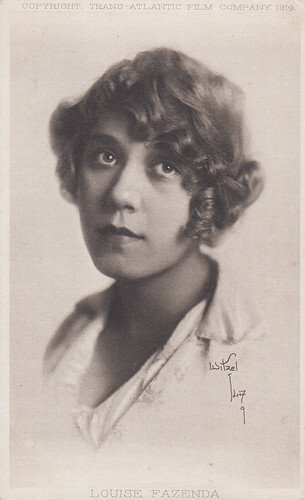
British postcard by Trans-Atlantic Film Company, 1914. Photo: Witzel, Hollywood.
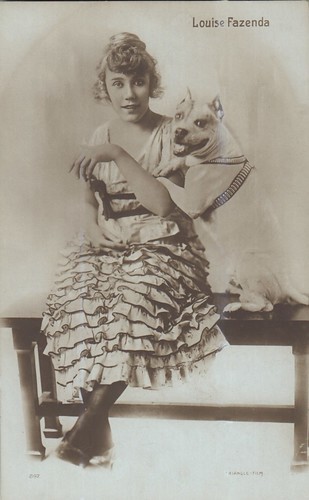
Swedish postcard by Förlag Nordisk Konst, no. 897. Photo: Triangle Film.
Joker comedies
Louise Fazenda was born on the 17th of June 1895 or 1896 in Indiana, U.S.A. Her father, Joseph Fazenda, was born in Mexico and was of European descent, and her mother, Nelda Schilling, was born in Chicago.
At the beginning of the 1910s, her father’s grocery store folded and Louise had to find a way to support her family.
She then turned to acting and was soon signed by Universal, which quickly made her join their new Joker Comedy unit.
In 1913 and 1914, she often appeared as leading lady to comedians such as Max Asher, Harry McCoy or Bobby Vernon.
Her Joker shorts include Almost an Actress (1913), Lazy Louis (1913), She Should Worry (1913), The Mystery of a Taxicab (1914), Heaven Will Protect the Working Girl (1914), Love, Roses and Trousers (1914), What Happened to Schulz? (1914), Lizzie’s Fortune (1914), etc.
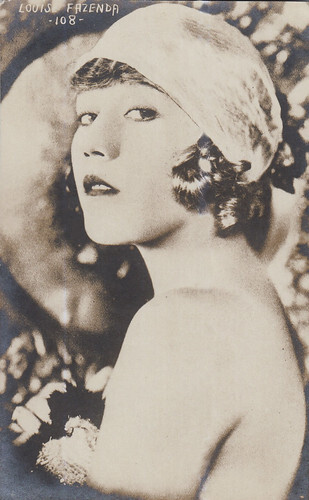
Artura postcard, no. 108.
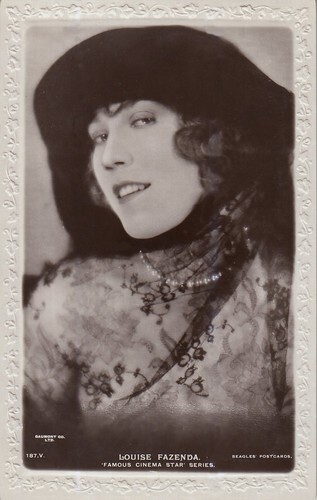
British postcard in the Famous Cinema Stars Series by Beagles, no. 187 V. Photo: Gaumont Co. LTD.
A contract to Mack Sennett
In the mid-1910s, Louise Fazenda had her big break when she got a contract from Mack Sennett and her popularity quickly soared.
Although an attractive woman in real life, Louise Fazenda never hesitated to appear unglamorous or gawky onscreen for comic effects, wearing plain clothes or sporting eccentric hairdos. She was not averse to playing country girls, maids, cooks or other unprepossessing characters.
She became one of the most famous female clowns of her time and was featured until the beginning of the 1920s in countless shorts such as Willful Ambrose (1915), A Versatile Villain (1915), Her Marble Heart (1916), Bombs! (1916), Maggie’s First False Step (1917), Her Fame and Shame (1917), Her Torpedoed Love (1917), The Betrayal of Maggie (1917), Are Waitresses Safe? (1917), The Kitchen Lady (1918), Her Screen Idol (1918), The Village Chestnut (1918), Heart and Flowers (1919), Back to the Kitchen (1919), The Gingham Girl (1920), Let’er Go (1920), Bungalow Troubles (1921), Made in The Kitchen (1921), Astray from the Steerage (1921), …
In the feature-length rural comedy Down on the Farm (1920), she played, with her usual zest, a farmer’s daughter opposite other Sennett popular players such as Ben Turpin , James Finlayson, Bert Roach, Harry Gribbon, Marie Prevost and Teddy, the dog.
Louise Fazenda's last film for Mack Sennett was Bow Wow (1922).
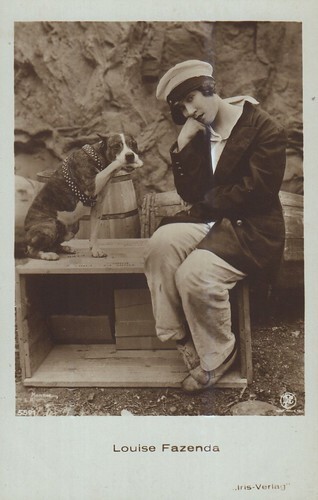
Austrian postcard by Iris Verlag, no. 5591. Photo: Monroe, L.A. / DPC.
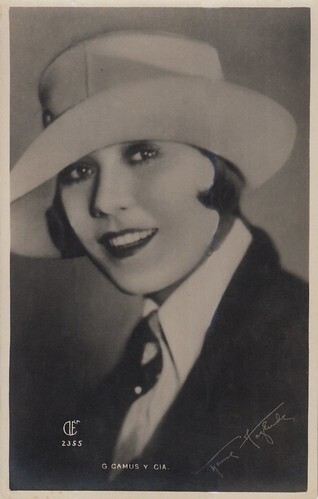
Mexican postcard by CIF, no. 2355.
A prolific and eclectic actress
In the 1920s, Louise Fazenda played comedy as well as dramatic roles for various studios.
Among her films were Quincy Adams Sawyer (1922), The Fog (1923), The Gold Diggers (1923), The Old Fool (1923), The Galloping Fish (1924), Listen Lester (1924), Being Respectable (1924), The Lighthouse by the Sea (1924), The Night Club (1925), The Love Hour (1925), Compromise (1925), Hogan’s Alley (1925), The Bat (1926), Footloose Widows (1926), The Passionate Quest (1926), Millionaires (1926), Ladies at Play (1926), Finger Prints (1927), The Cradle Snatchers (1927), Simple Sis (1927), Domestic Troubles (1928), Tillie’s Punctured Romance (1928), Pay as You Enter (1928), Five and Ten Cent Annie (1928), …
Thirteen years apart, she played the same character, Bea Sorenson, in Main Street (1923) and I Married a Doctor (1936), both adapted from Sinclair Lewis’s famous novel about small-town life.
Occasionally, she again appeared in several shorts such as Pest of the Storm Country (1923), Cold Chills (1923) and Dizzy Daisy (1924).
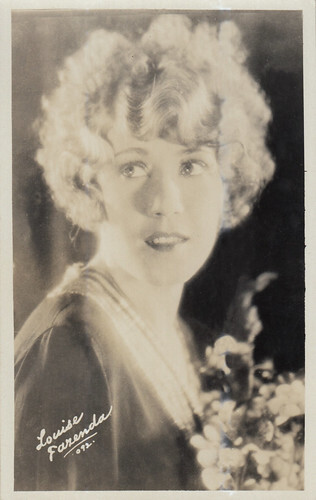
Gevaert postcard, no. 092.
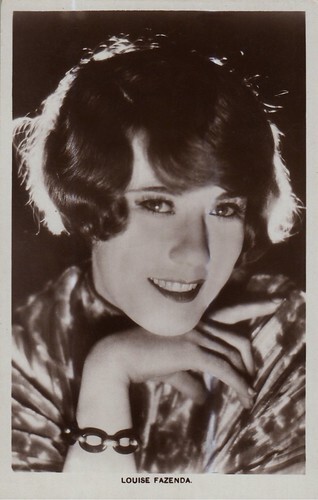
British postcard by Picturegoer, no. 367.
The talkies
Louise Fazenda made her talking debut in the mystery thriller The Terror (1928) and found herself still in demand during the following years.
She often performed in comedies and musicals but could also be seen in dramas now and then.
She was offered roles in, for example, On with the Show (1929), Stark Mad (1929), The Broadway Hoofer (1929), No, No, Nanette (1930), Rain or Shine (1930), Misbehaving Ladies (1931), Newly Rich (1931), The Mad Parade (1931), Racing Youth (1932), Once in a Lifetime (1932), Caravan (1934), The Winning Ticket (1935), The Casino Murder Case (1935), Broadway Gondolier (1935), Doughnuts and Society (1936), The Road Back (1937), Merry-Go-Round of 1938 (1937), Swing Your Lady (1938), Down on the Farm (1938), etc.
Fazenda also appeared in the star-studded fantasy film Alice in Wonderland (1933), as the White Queen.
She starred again in shorts such as Faro Nell (1929), So This Is Paris Green (1930), A Fall to Arms (1930), Second Hand Kisses (1931), Hunting Trouble (1933) or Stung Again (1933). She retired after The Old Maid (1939), a successful Bette Davis melodrama.
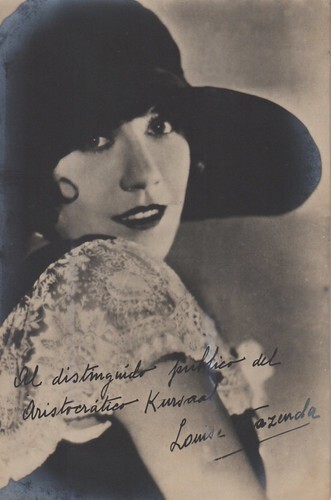
Spanish postcard in the Kursaal series.
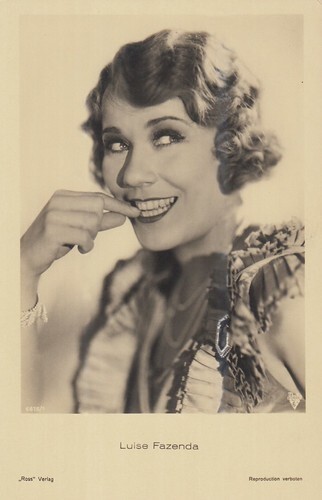
German postcard by Ross Verlag, no. 6615/1, 1931-1932. Photo: RKO Radio Pictures.
Mrs. Hal B. Wallis
After her divorce in 1926 from her first husband, director Noel M. Smith, Louise Fazenda married in 1927 publicist Hal B. Wallis. He would later become a famous producer, known for such classics as The Maltese Falcon (1941), Now, Voyager (1942), Casablanca (1942) and Gunfight at the O.K. Corral (1957).
In Hollywood circles, he was often wittily referred to as 'The Prisoner of Fazenda', in reference to the successful adventure novel 'The Prisoner of Zenda'. They had a son in 1933.
Louise Fazenda devoted herself to philanthropy and charity work after her prolific movie career had ended. She spent time helping people in need and volunteering at hospitals.
She was also one of the main benefactors of the McKinley Home for Boys, who looked after orphans or kids whose families could not care for. A framed quote she kept on her night table read: "May I never leave a lame dog by a stile, but lift it to the other side and make its life worthwhile".
After several years of failing health, Louise Fazenda passed away on the 17th of April 1962, from a brain haemorrhage.
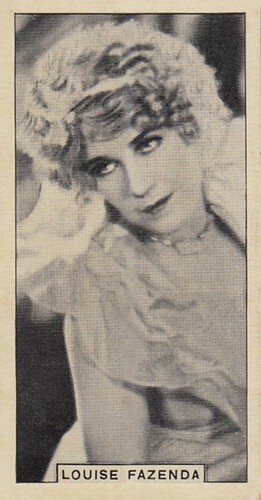
Cigarette card issued with Albert cigarettes in the 'Artistes de cinéma' series, no. 88.
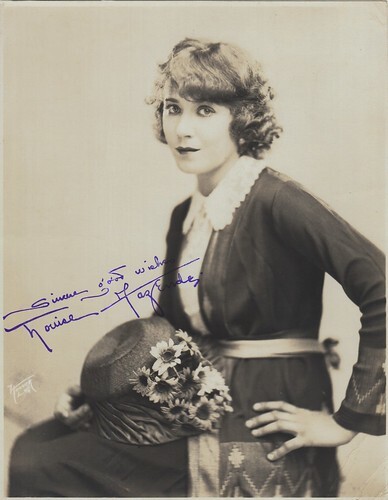
Autographed photograph. Photo: Hoover, L.A.
Text and postcards: Marlene Pilaete.

British postcard by Photochrom Co. Ltd., London no. 111. Photo: Triangle / Keystone.

British postcard by Trans-Atlantic Film Company, 1914. Photo: Witzel, Hollywood.

Swedish postcard by Förlag Nordisk Konst, no. 897. Photo: Triangle Film.
Joker comedies
Louise Fazenda was born on the 17th of June 1895 or 1896 in Indiana, U.S.A. Her father, Joseph Fazenda, was born in Mexico and was of European descent, and her mother, Nelda Schilling, was born in Chicago.
At the beginning of the 1910s, her father’s grocery store folded and Louise had to find a way to support her family.
She then turned to acting and was soon signed by Universal, which quickly made her join their new Joker Comedy unit.
In 1913 and 1914, she often appeared as leading lady to comedians such as Max Asher, Harry McCoy or Bobby Vernon.
Her Joker shorts include Almost an Actress (1913), Lazy Louis (1913), She Should Worry (1913), The Mystery of a Taxicab (1914), Heaven Will Protect the Working Girl (1914), Love, Roses and Trousers (1914), What Happened to Schulz? (1914), Lizzie’s Fortune (1914), etc.

Artura postcard, no. 108.

British postcard in the Famous Cinema Stars Series by Beagles, no. 187 V. Photo: Gaumont Co. LTD.
A contract to Mack Sennett
In the mid-1910s, Louise Fazenda had her big break when she got a contract from Mack Sennett and her popularity quickly soared.
Although an attractive woman in real life, Louise Fazenda never hesitated to appear unglamorous or gawky onscreen for comic effects, wearing plain clothes or sporting eccentric hairdos. She was not averse to playing country girls, maids, cooks or other unprepossessing characters.
She became one of the most famous female clowns of her time and was featured until the beginning of the 1920s in countless shorts such as Willful Ambrose (1915), A Versatile Villain (1915), Her Marble Heart (1916), Bombs! (1916), Maggie’s First False Step (1917), Her Fame and Shame (1917), Her Torpedoed Love (1917), The Betrayal of Maggie (1917), Are Waitresses Safe? (1917), The Kitchen Lady (1918), Her Screen Idol (1918), The Village Chestnut (1918), Heart and Flowers (1919), Back to the Kitchen (1919), The Gingham Girl (1920), Let’er Go (1920), Bungalow Troubles (1921), Made in The Kitchen (1921), Astray from the Steerage (1921), …
In the feature-length rural comedy Down on the Farm (1920), she played, with her usual zest, a farmer’s daughter opposite other Sennett popular players such as Ben Turpin , James Finlayson, Bert Roach, Harry Gribbon, Marie Prevost and Teddy, the dog.
Louise Fazenda's last film for Mack Sennett was Bow Wow (1922).

Austrian postcard by Iris Verlag, no. 5591. Photo: Monroe, L.A. / DPC.

Mexican postcard by CIF, no. 2355.
A prolific and eclectic actress
In the 1920s, Louise Fazenda played comedy as well as dramatic roles for various studios.
Among her films were Quincy Adams Sawyer (1922), The Fog (1923), The Gold Diggers (1923), The Old Fool (1923), The Galloping Fish (1924), Listen Lester (1924), Being Respectable (1924), The Lighthouse by the Sea (1924), The Night Club (1925), The Love Hour (1925), Compromise (1925), Hogan’s Alley (1925), The Bat (1926), Footloose Widows (1926), The Passionate Quest (1926), Millionaires (1926), Ladies at Play (1926), Finger Prints (1927), The Cradle Snatchers (1927), Simple Sis (1927), Domestic Troubles (1928), Tillie’s Punctured Romance (1928), Pay as You Enter (1928), Five and Ten Cent Annie (1928), …
Thirteen years apart, she played the same character, Bea Sorenson, in Main Street (1923) and I Married a Doctor (1936), both adapted from Sinclair Lewis’s famous novel about small-town life.
Occasionally, she again appeared in several shorts such as Pest of the Storm Country (1923), Cold Chills (1923) and Dizzy Daisy (1924).

Gevaert postcard, no. 092.

British postcard by Picturegoer, no. 367.
The talkies
Louise Fazenda made her talking debut in the mystery thriller The Terror (1928) and found herself still in demand during the following years.
She often performed in comedies and musicals but could also be seen in dramas now and then.
She was offered roles in, for example, On with the Show (1929), Stark Mad (1929), The Broadway Hoofer (1929), No, No, Nanette (1930), Rain or Shine (1930), Misbehaving Ladies (1931), Newly Rich (1931), The Mad Parade (1931), Racing Youth (1932), Once in a Lifetime (1932), Caravan (1934), The Winning Ticket (1935), The Casino Murder Case (1935), Broadway Gondolier (1935), Doughnuts and Society (1936), The Road Back (1937), Merry-Go-Round of 1938 (1937), Swing Your Lady (1938), Down on the Farm (1938), etc.
Fazenda also appeared in the star-studded fantasy film Alice in Wonderland (1933), as the White Queen.
She starred again in shorts such as Faro Nell (1929), So This Is Paris Green (1930), A Fall to Arms (1930), Second Hand Kisses (1931), Hunting Trouble (1933) or Stung Again (1933). She retired after The Old Maid (1939), a successful Bette Davis melodrama.

Spanish postcard in the Kursaal series.

German postcard by Ross Verlag, no. 6615/1, 1931-1932. Photo: RKO Radio Pictures.
Mrs. Hal B. Wallis
After her divorce in 1926 from her first husband, director Noel M. Smith, Louise Fazenda married in 1927 publicist Hal B. Wallis. He would later become a famous producer, known for such classics as The Maltese Falcon (1941), Now, Voyager (1942), Casablanca (1942) and Gunfight at the O.K. Corral (1957).
In Hollywood circles, he was often wittily referred to as 'The Prisoner of Fazenda', in reference to the successful adventure novel 'The Prisoner of Zenda'. They had a son in 1933.
Louise Fazenda devoted herself to philanthropy and charity work after her prolific movie career had ended. She spent time helping people in need and volunteering at hospitals.
She was also one of the main benefactors of the McKinley Home for Boys, who looked after orphans or kids whose families could not care for. A framed quote she kept on her night table read: "May I never leave a lame dog by a stile, but lift it to the other side and make its life worthwhile".
After several years of failing health, Louise Fazenda passed away on the 17th of April 1962, from a brain haemorrhage.

Cigarette card issued with Albert cigarettes in the 'Artistes de cinéma' series, no. 88.

Autographed photograph. Photo: Hoover, L.A.
Text and postcards: Marlene Pilaete.
Published on March 27, 2025 23:00
March 26, 2025
Alice Brady
American stage and screen actress Alice Brady (1892–1939) began her career in the silent film era and survived the transition into talkies. Her typical film role was a wealthy, rather flighty society woman. In 1938, she received an Oscar for her role in In Old Chicago (1937).
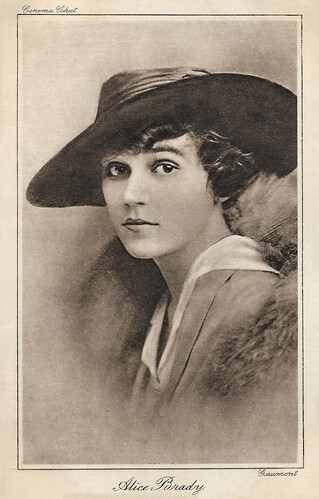
British postcard in the Cinema Chat series. Photo: Gaumont.
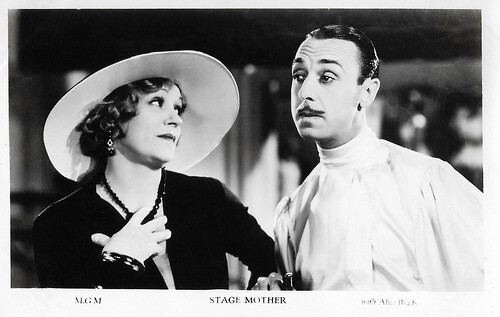
British postcard in the Film Weekly series. Photo: M.G.M. Alice Brady and Jay Eaton in Stage Mother (Charles Brabin, 1933).
World Film
Alice Brady was born Mary Rose Brady in 1892. She was the daughter of reputed theatrical producer William Brady. Her mother, French actress Rose Marie Rene, died in 1896. When Alice was a child her father married actress Grace George. Her half-brother was William A. Brady Jr, the son of her father and Grace George.
Mary Rose was interested at an early age in becoming an actress and she began her stage career when she was 14. She was educated in a convent school in Madison, New Jersey, and at the New England Conservatory of Music. She abandoned plans for an operatic career and, over her father’s objections, entered the theatre. The 18-year-old got her first job on Broadway in a minor role in 'The Mikado, a production with which her father was associated.
Billed as Mary Rose, Brady debuted on stage in 1911 in New Haven in the operetta 'The Balkan Princess'. Her first important success came on Broadway in 1912 when she created the role of Meg March in the original production of Marian de Forest's 'Little Women', a play adapted from the novel by Louisa May Alcott.
Brady's father moved into film production in 1913 with his new company World Film. Alice soon followed him, making her first silent feature appearance in As Ye Sow (Frank Hall Crane, 1914) with Douglas MacLean. Another twenty films at the World Film Corporation followed in which she played various roles - a Russian countess, an immigrant, and a dancer. She continued to perform on the New York stage, as World Film was situated nearby, in Fort Lee, New Jersey.
Now mostly forgotten, World Film was highly active during the 1910s as a production and distribution company, which even had a separate, all-French section with French emigre directors such as Léonce Perret, Emile Chautard, Maurice Tourneur, and Albert Capellani. In 1918 Alice returned to Broadway in the hit 'Forever After'.
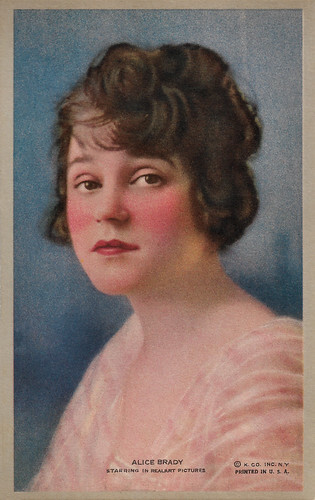
American postcard by K. Co. Inc., New York, no. 149. Photo: Realart Pictures.
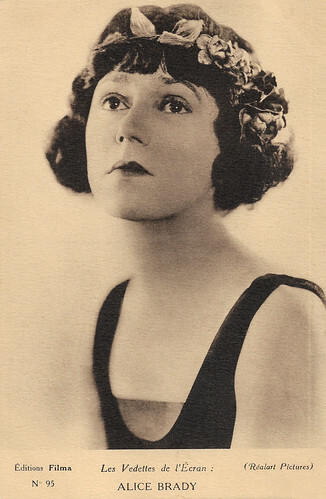
French postcard by Editions Filma in the Les Vedettes de l'Écran series, no. 95. Photo: Realart Pictures, c. 1921.
Select Films, Realart Pictures and Paramount
In 1918 Alice Brady moved to Select Pictures of former World Film manager Lewis Selznick, the father of David O. Selznick. In 1918-1919, she appeared in a dozen films, such as Woman and Wife (Edward José, 1918) and At the Mercy of Men (Charles Miller, 1918), and worked with American and French émigré directors such as Alan Crosland and Emile Chautard.
In 1921 Brady acted at Realart Pictures and in 1921-1923 at Paramount. In 1923, Brady stopped appearing in films to concentrate on stage acting. She enjoyed great successes in 'Zander the Great' (1923), 'Old Mama' (1925), and 'The Bride of the Lamb' (1926). In 1931 she appeared in the premiere of Eugene O'Neill's famous play 'Mourning Becomes Electra' with Alla Nazimova . A year later, she acted in 'Mademoiselle' (1932). She did not appear on the screen until 1933.
In 1933, she made the move to Hollywood and M-G-M's When Ladies Meet became her first talking picture. Her talents on the stage aided her successful transition from silent movies to talkies. Alice Brady acted in another 25 sound films, including the musical The Gay Divorcee (Mark Sandrich, 1934) starring Fred Astaire and Ginger Rogers , Three Smart Girls (Henry Koster, 1936) and One Hundred Men and a Girl (Henry Koster, 1937) with Deanna Durbin . In the comedy My Man Godfrey (Gregory La Cava, 1936), she played the flighty and socially ambitious mother of Carole Lombard 's character. Brady was nominated for an Oscar for her role but lost.
In 1938, she won the Academy Award for Best Supporting Actress as Mrs. Molly O'Leary, the mother of Tyrone Power in In Old Chicago (Henry King, 1937). A long-enduring myth retold on Dutch Wikipedia, states that at the Academy Awards presentation dinner, Brady's Oscar was stolen by a man who came onstage to accept the award on the actress's behalf. She was absent due to a broken ankle According to the myth, the statuet was never recovered, and the impostor was never tracked down. However, according to the press at the time the film's director, Henry King, accepted on her behalf at the ceremony and friends of Ms. Brady delivered it to her home later that night. Winners were given blank awards at the ceremony and returned them to the Academy to have them engraved afterwards. In 2016, the Oscar historian Olivia Rutigliano noted that Brady also followed this practice, which may have led to the story that the Academy was presenting her with a replacement trophy that never reached her because of her early death.
Alice Brady worked until six months before her death from cancer in 1939. Her final film was Young Mr. Lincoln (John Ford, 1939) starring Henry Fonda . She was only 46 years old when she died in New York. All in all, she acted in some 80 films. Between 1919 and 1922 Alice Brady was married to actor James Crane, with whom she acted in three films and had one son, Donald William Crane who died in 1942. She was interred at Sleepy Hollow Cemetery in New York. In 1960, Brady received posthumously a Motion Pictures Star on the Hollywood Walk of Fame for her contributions to the film industry. Her star is located at 6201 Hollywood Boulevard.
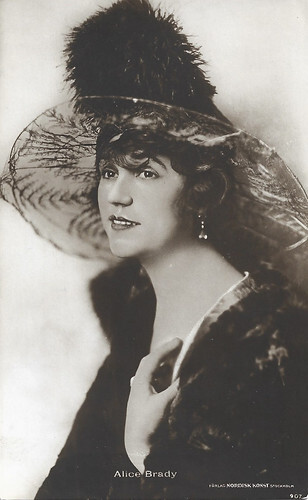
Swedish postcard by Förlag Nordisk Konst, Stockholm, no. 907.
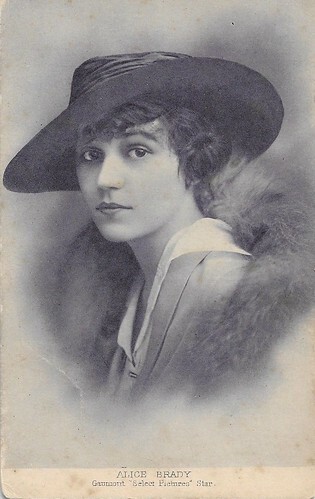
British postcard. Photo: Gaumont / Select Pictures. Select Pictures refers to the American production company Select Pictures (1917-1923) by Lewis Selznick, which he had founded in 1916 as Selznick Pictures, after losing control of the company World Film.
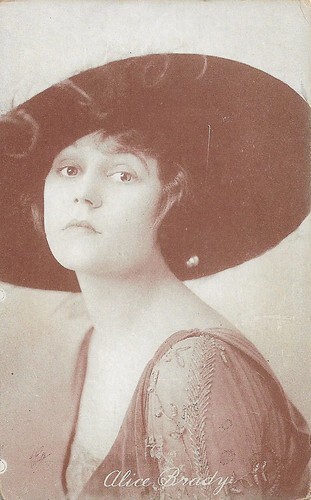
American postcard.
Source: (IMDb), Wikipedia (Dutch, French and English), and .

British postcard in the Cinema Chat series. Photo: Gaumont.

British postcard in the Film Weekly series. Photo: M.G.M. Alice Brady and Jay Eaton in Stage Mother (Charles Brabin, 1933).
World Film
Alice Brady was born Mary Rose Brady in 1892. She was the daughter of reputed theatrical producer William Brady. Her mother, French actress Rose Marie Rene, died in 1896. When Alice was a child her father married actress Grace George. Her half-brother was William A. Brady Jr, the son of her father and Grace George.
Mary Rose was interested at an early age in becoming an actress and she began her stage career when she was 14. She was educated in a convent school in Madison, New Jersey, and at the New England Conservatory of Music. She abandoned plans for an operatic career and, over her father’s objections, entered the theatre. The 18-year-old got her first job on Broadway in a minor role in 'The Mikado, a production with which her father was associated.
Billed as Mary Rose, Brady debuted on stage in 1911 in New Haven in the operetta 'The Balkan Princess'. Her first important success came on Broadway in 1912 when she created the role of Meg March in the original production of Marian de Forest's 'Little Women', a play adapted from the novel by Louisa May Alcott.
Brady's father moved into film production in 1913 with his new company World Film. Alice soon followed him, making her first silent feature appearance in As Ye Sow (Frank Hall Crane, 1914) with Douglas MacLean. Another twenty films at the World Film Corporation followed in which she played various roles - a Russian countess, an immigrant, and a dancer. She continued to perform on the New York stage, as World Film was situated nearby, in Fort Lee, New Jersey.
Now mostly forgotten, World Film was highly active during the 1910s as a production and distribution company, which even had a separate, all-French section with French emigre directors such as Léonce Perret, Emile Chautard, Maurice Tourneur, and Albert Capellani. In 1918 Alice returned to Broadway in the hit 'Forever After'.

American postcard by K. Co. Inc., New York, no. 149. Photo: Realart Pictures.

French postcard by Editions Filma in the Les Vedettes de l'Écran series, no. 95. Photo: Realart Pictures, c. 1921.
Select Films, Realart Pictures and Paramount
In 1918 Alice Brady moved to Select Pictures of former World Film manager Lewis Selznick, the father of David O. Selznick. In 1918-1919, she appeared in a dozen films, such as Woman and Wife (Edward José, 1918) and At the Mercy of Men (Charles Miller, 1918), and worked with American and French émigré directors such as Alan Crosland and Emile Chautard.
In 1921 Brady acted at Realart Pictures and in 1921-1923 at Paramount. In 1923, Brady stopped appearing in films to concentrate on stage acting. She enjoyed great successes in 'Zander the Great' (1923), 'Old Mama' (1925), and 'The Bride of the Lamb' (1926). In 1931 she appeared in the premiere of Eugene O'Neill's famous play 'Mourning Becomes Electra' with Alla Nazimova . A year later, she acted in 'Mademoiselle' (1932). She did not appear on the screen until 1933.
In 1933, she made the move to Hollywood and M-G-M's When Ladies Meet became her first talking picture. Her talents on the stage aided her successful transition from silent movies to talkies. Alice Brady acted in another 25 sound films, including the musical The Gay Divorcee (Mark Sandrich, 1934) starring Fred Astaire and Ginger Rogers , Three Smart Girls (Henry Koster, 1936) and One Hundred Men and a Girl (Henry Koster, 1937) with Deanna Durbin . In the comedy My Man Godfrey (Gregory La Cava, 1936), she played the flighty and socially ambitious mother of Carole Lombard 's character. Brady was nominated for an Oscar for her role but lost.
In 1938, she won the Academy Award for Best Supporting Actress as Mrs. Molly O'Leary, the mother of Tyrone Power in In Old Chicago (Henry King, 1937). A long-enduring myth retold on Dutch Wikipedia, states that at the Academy Awards presentation dinner, Brady's Oscar was stolen by a man who came onstage to accept the award on the actress's behalf. She was absent due to a broken ankle According to the myth, the statuet was never recovered, and the impostor was never tracked down. However, according to the press at the time the film's director, Henry King, accepted on her behalf at the ceremony and friends of Ms. Brady delivered it to her home later that night. Winners were given blank awards at the ceremony and returned them to the Academy to have them engraved afterwards. In 2016, the Oscar historian Olivia Rutigliano noted that Brady also followed this practice, which may have led to the story that the Academy was presenting her with a replacement trophy that never reached her because of her early death.
Alice Brady worked until six months before her death from cancer in 1939. Her final film was Young Mr. Lincoln (John Ford, 1939) starring Henry Fonda . She was only 46 years old when she died in New York. All in all, she acted in some 80 films. Between 1919 and 1922 Alice Brady was married to actor James Crane, with whom she acted in three films and had one son, Donald William Crane who died in 1942. She was interred at Sleepy Hollow Cemetery in New York. In 1960, Brady received posthumously a Motion Pictures Star on the Hollywood Walk of Fame for her contributions to the film industry. Her star is located at 6201 Hollywood Boulevard.

Swedish postcard by Förlag Nordisk Konst, Stockholm, no. 907.

British postcard. Photo: Gaumont / Select Pictures. Select Pictures refers to the American production company Select Pictures (1917-1923) by Lewis Selznick, which he had founded in 1916 as Selznick Pictures, after losing control of the company World Film.

American postcard.
Source: (IMDb), Wikipedia (Dutch, French and English), and .
Published on March 26, 2025 23:00
March 25, 2025
Ross Verlag, Part 28: Künstler im Film
A small part of our European film star postcard collection is formed by vintage cigarette cards - small, colourful treasures from the past. During the 1930s, Ross-Verlag in Berlin produced several series for German cigarette manufacturers. The cards were included in the cigarette packets and could be glued in special albums. For Zigarettenfabrik Monopol in Dresden, Ross made in the mid-1930s the series 'Künstler im Film' (Artists in Film) with 200 cards of 5,5 cm by 6,5 cm. In this post, EFSP reproduces 28 of the cards with international stars. The backsides contain info about when the star was born, how you could contact him or her (mostly through the studio) and the title(s) of his or her latest film(s).

German cigarette card by Ross Verlag in the 'Künstler im Film' series for Zigarettenfabrik Monopol, Dresden, Serie 1, image 1. Photo: Ufa.
Beautiful Lída Baarová (1914-2000) was a glamorous Czech film star who worked in Prague, Berlin, and Rome. A dangerous affair with Joseph Goebbels, the propaganda minister of the Third Reich, first enhanced and later seriously damaged her career.
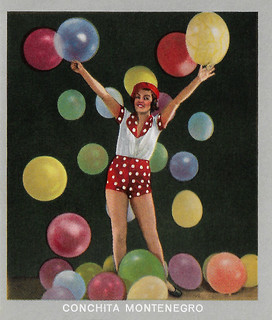
German cigarette card by Ross Verlag in the 'Künstler im Film' series for Zigarettenfabrik Monopol, Dresden, Serie 1, image 8. Photo: Metro-Goldwyn-Mayer.
Conchita Montenegro (1911-2007) was a Spanish model, dancer, and stage and screen actress. She starred in several Spanish productions, but also in French, German and American films.

German cigarette card by Ross Verlag in the 'Künstler im Film' series for Zigarettenfabrik Monopol, Dresden, Serie 1, image 13 (of 200). Photo: Ufa.
German actress Carola Höhn (1910-2005) had a 60 years lasting film career. She began as the elegant star of many Ufa productions and later became the acclaimed Grande Dame of the German post-war cinema.
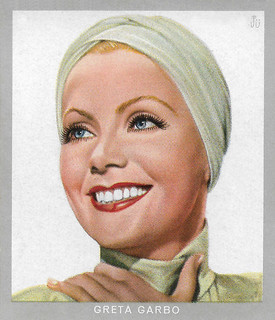
German cigarette card by Ross Verlag in the 'Künstler im Film' series for Zigarettenfabrik Monopol, Dresden, Serie 1, image 18. Photo: Metro-Goldwyn-Mayer. Greta Garbo in The Painted Veil (Richard Boleslawski, 1934).
Swedish Greta Garbo (1905-1990) was one of the greatest and most glamorous film stars ever produced by the Hollywood studio system. She was part of the Golden Age of the silent cinema of the 1920s and was one of the few actors who made a glorious transition to the talkies. She started her career in the European cinema and would always stay more popular in Europe than in the USA.
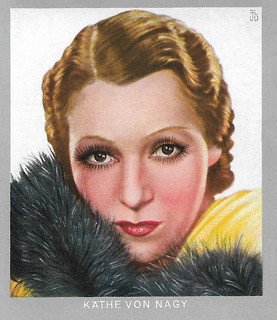
German cigarette card by Ross Verlag in the 'Künstler im Film' series for Zigarettenfabrik Monopol, Dresden, Serie 1, image 30 (of 200). Photo: Itala-Film.
Hungarian actress Käthe von Nagy (1904-1973) started as the ‘Backfish’ of German films of the late 1920s. In the early 1930s, she became a fashionable and charming star of German and French cinema.
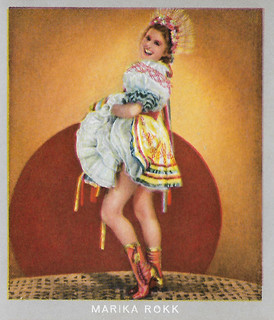
German cigarette card by Ross Verlag in the 'Künstler im Film' series for Zigarettenfabrik Monopol, Dresden, Serie 1, image 39 (of 200). Photo: Ufa.
Egyptian-born singer, dancer, and actress of Hungarian descent Marika Rökk (1913-2004) was the last film diva of the Ufa. She was an immensely talented musical performer who could tap with the rhythm and vitality of her Hollywood counterpart Eleanor Powell, and switch to balletic movements with the conviction of Cyd Charisse. Her trademark was her Hungarian accent.
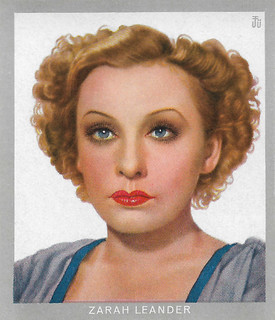
German cigarette card by Ross Verlag in the 'Künstler im Film' series for Zigarettenfabrik Monopol, Dresden, Serie 1, image 41 (of 200). Photo: Gloria-Syndikat.
Glamorous, mysterious diva Zarah Leander (1907-1981) was a Swedish actress and singer, who is now best remembered for her German songs and films from the late 1930s and early 1940s. With her fascinating and deep voice, she sang melancholic and a bit frivolous songs that were specifically composed for her. Zarah was for a time the best-paid film star of the Third Reich. In her Ufa vehicles, she always played the role of a cool femme fatale, independently minded, beautiful, passionate, self-confident and a bit sad. It gave her the nickname 'the Nazi Garbo', but a recent book claims that she was, in fact, a Soviet spy.
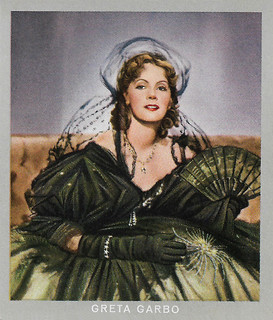
German cigarette card by Ross Verlag in the 'Künstler im Film' series for Zigarettenfabrik Monopol, Dresden, Serie 1, image 88 (from 200). Photo: Metro-Goldwyn-Mayer. Greta Garbo in Camille (George Cukor, 1936).
Swedish Greta Garbo (1905-1990) was one of the greatest and most glamorous film stars ever produced by the Hollywood studio system. She was part of the Golden Age of the silent cinema of the 1920s and was one of the few actors who made a glorious transition to the talkies. She started her career in the European cinema and would always stay more popular in Europe than in the USA.
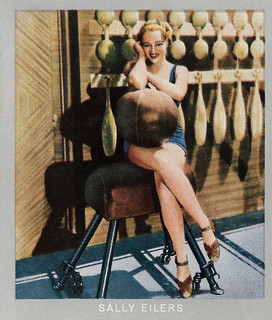
German cigarette card by Ross Verlag in the 'Künstler im Film' series for Zigarettenfabrik Monopol, Dresden, Serie 1, image 104 (of 200). Photo: 20th Century Fox.
American actress Sally Eilers (1908-1978) was a popular Hollywood star in the early-1930s. She was tagged 'the most beautiful girl in movies'.
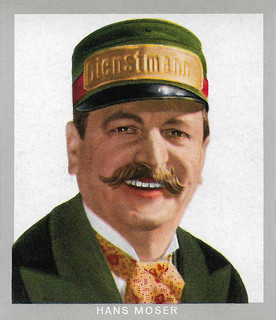
German cigarette card by Ross Verlag in the 'Künstler im Film' series for Zigarettenfabrik Monopol, Dresden, Serie 1, image 110 (of 200). Photo: Manassé-Ricoll. Hans Moser in Der Dienstmann (Adolf Rosen, 1932).
Austrian actor Hans Moser (1880-1964) appeared in over 150 films. During his long career, from the 1920s up to his death, he became very popular as the mumbling factotum in comedy films. Moser was particularly associated with the genre of the Wiener Film.
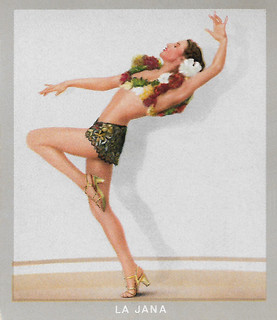
German cigarette card by Ross Verlag in the 'Künstler im Film' series for Zigarettenfabrik Monopol, Dresden, Serie 1, image 115 (of 200). Photo: Dührkoop.
Sexy German dancer and film actress La Jana (1905-1940) was the most popular showgirl in Berlin in the 1930s. She appeared in 25 European films, often dancing in exotic costumes. In 1940, she suddenly died of pneumonia and pleurisy.
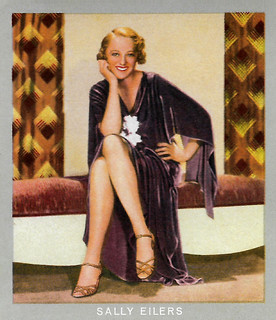
German cigarette card by Ross Verlag in the 'Künstler im Film' series for Zigarettenfabrik Monopol, Dresden, Serie 1, image 116 (of 200). Photo: Fox-Film.
American actress Sally Eilers (1908-1978) was a popular Hollywood star in the early-1930s. She was tagged 'the most beautiful girl in movies'.
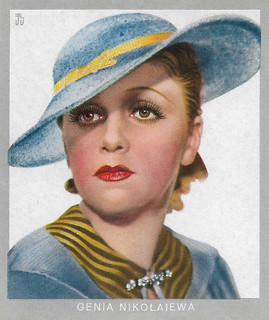
German cigarette card by Ross Verlag in the 'Künstler im Film' series for Zigarettenfabrik Monopol, Dresden, Serie 1, image 121. Photo: Ariel / Tobis / Rota.
Russian-born ballet dancer and actress Genia Nikolaieva (1904-2001) worked in the German cinema during the 1930s. In 1938 she emigrated to the United States, where she became ‘one of the most beautiful studio secretaries for Warner Bros'.
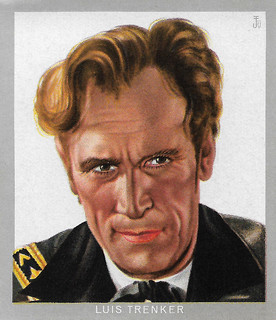
German cigarette card by Ross Verlag in the 'Künstler im Film' series for Zigarettenfabrik Monopol, Dresden, Serie 1, image 125 (of 200). Photo: Trenker / Tobis / Rota.
Luis Trenker (1892-1990) was an Austrian-Italian ski champion, mountain climber, architect, film director, and actor. He portrayed rugged, daring outdoorsmen in the Mountain Film, the genre which seemed to be created especially for him. His films glorified epic struggles such as colonization and wars for freedom and were set against spectacular, usually mountainous landscapes.
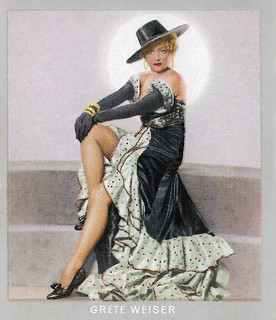
German cigarette card by Ross Verlag in the 'Künstler im Film' series for Zigarettenfabrik Monopol, Dresden, Serie 1, image 130. Photo: Ufa
Grethe Weiser (1903-1970) was a German singer, comedian, film and stage actress. She made more than 140 films.
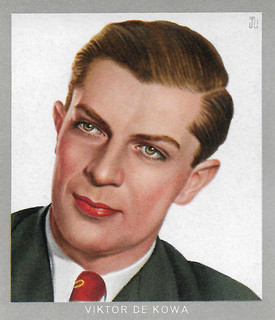
German cigarette card by Ross Verlag in the 'Künstler im Film' series for Zigarettenfabrik Monopol, Dresden, Serie 1, image 133 (of 200). Photo: Binder, Berlin.
Viktor de Kowa (1904-1973) was a German actor, singer, director and comedy writer. In the 1930s he became one of the most prominent and beloved comedy actors of the German cinema.
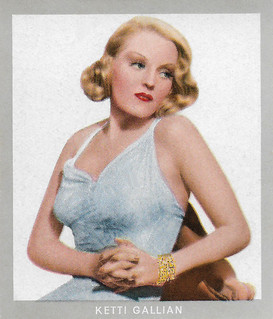
German cigarette card by Ross Verlag in the 'Künstler im Film' series for Zigarettenfabrik Monopol, Dresden, Serie 1, image 134 (of 200). Photo: Paramount.
Ketti Gallian (1912-1972) was a blonde French actress, who starred in films by Paramount and Fox during the 1930s. Her Hollywood career was not a success and she returned to France, where she acted in films till 1956.
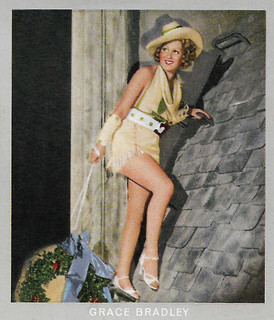
German cigarette card by Ross Verlag in the 'Künstler im Film' series for Zigarettenfabrik Monopol, Dresden, Serie 1, image 141 (of 200). Photo: Paramount.
Grace Bradley (1913-2010) was a petite, seductive and sassy American actress who played 'good-time' girls in many second-feature thrillers and musicals of the 1930s and 1940s. She was the fifth and last wife of William 'Hoppalong Cassidy' Boyd.
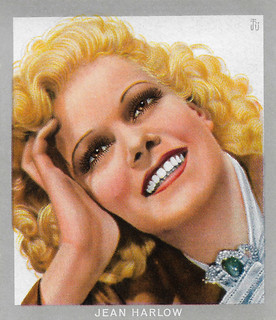
German cigarette card by Ross Verlag in the 'Künstler im Film' series for Zigarettenfabrik Monopol, Dresden, Serie 1, image 143 (of 200). Photo: Metro-Goldwyn-Mayer Studios.
American film actress Jean Harlow (1911–1937) was one of the sex symbols of the 1930s.
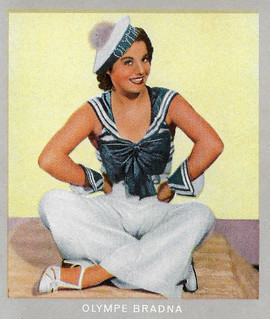
German cigarette card by Ross Verlag in the 'Künstler im Film' series for Zigarettenfabrik Monopol, Dresden, Serie 1, image 146 (of 200). Photo: Paramount.
Brunette Olympe Bradna (1920-2012) was a French dancer and actress, who danced in Paris, Stockholm, New York City, and other world capitals. In Hollywood, she appeared in more than a dozen films and starred opposite Ronald Reagan, George Raft and Gary Cooper. In the majority of her films, she played the ornamental love interest of sporting champs or war heroes and had little else to do.
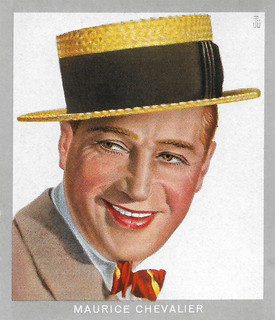
German cigarette card by Ross Verlag in the 'Künstler im Film' series for Zigarettenfabrik Monopol, Dresden, Serie 1, image 148 (of 200). Photo: Paramount.
Maurice Chevalier (1888-1972) was a French actor, singer, and entertainer with a very successful Hollywood career. His trademark was a casual straw hat, which he always wore on stage with a cane and a tuxedo.
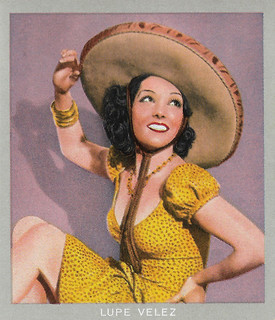
German cigarette card by Ross Verlag in the 'Künstler im Film' series for Zigarettenfabrik Monopol, Dresden, Serie 1, image 152 (of 200). Photo: Paramount. Lupe Velez in The Broken Wing (Lloyd Corrigan, 1932).
Lupe Velez (1908-1944), was one of the first Mexican actresses to succeed in Hollywood. Her nicknames were 'The Mexican Spitfire' and 'Hot Pepper'. She was the leading lady in such silent films as The Gaucho (1927), Lady of the Pavements (1928), and Wolf Song (1929). During the 1930s, her well-known explosive screen persona was exploited in a series of successful films like Hot Pepper (1933), Strictly Dynamite (1934), and Hollywood Party (1934). In the 1940s, Vélez's popularity peaked after appearing in the Mexican Spitfire films, a series created to capitalise on Vélez's well-documented fiery personality. She had several highly publicised romances and a stormy marriage. In 1944, Vélez died of an intentional overdose of the barbiturate drug Seconal. Her death and the circumstances surrounding it have been the subject of speculation and controversy.
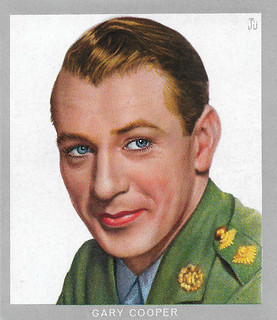
German cigarette card by Ross Verlag in the 'Künstler im Film' series for Zigarettenfabrik Monopol, Dresden, Serie 1, image 162 (of 200). Photo: Metro-Goldwyn-Mayer.
American screen legend Gary Cooper (1901-1961) is well remembered for his stoic, understated acting style in more than one hundred Westerns, comedies and dramas. He received five Oscar nominations and won twice for his roles as Alvin York in Sergeant York (1941) and as Will Kane in High Noon (1952).
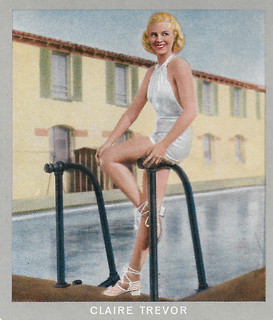
German cigarette card by Ross Verlag in the 'Künstler im Film' series for Zigarettenfabrik Monopol, Dresden, Serie 1, image 164 (of 200). Photo: 20th Century Fox.
American actress Claire Trevor (1910-2000) appeared in 68 feature films from 1933 to 1982. She often played the hard-boiled blonde or another type of shady lady. She won the Oscar for Best Supporting Actress for her role in Key Largo (1948) and received nominations for her roles in Dead End (1937) and The High and the Mighty (1954). But she is now best known for John Ford's classic Western Stagecoach (1939) with John Wayne.
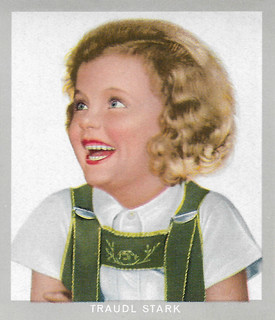
German cigarette card by Ross Verlag in the 'Künstler im Film' series for Zigarettenfabrik Monopol, Dresden, Serie 1, image 172 (of 200). Photo: Mondial-Film.
Austrian child actress Traudl Stark (1930) was the Shirley Temple of the German cinema. Between 1935 and 1940 she made a dozen popular films in Austria.
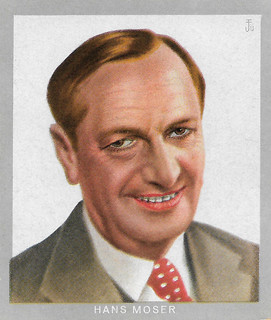
German cigarette card by Ross Verlag in the 'Künstler im Film' series for Zigarettenfabrik Monopol, Dresden, Serie 1, image 189 (of 200). Photo: Syndikat-Film.
Austrian actor Hans Moser (1880-1964) appeared in over 150 films. During his long career, from the 1920s up to his death, he became very popular as the mumbling factotum in comedy films. Moser was particularly associated with the genre of the Wiener Film.
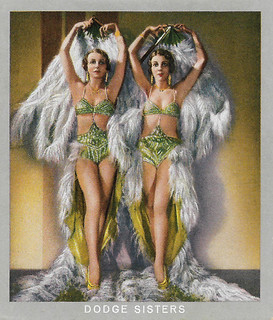
German cigarette card by Ross Verlag in the 'Künstler im Film' series for Zigarettenfabrik Monopol, Dresden, Serie 1, image 192 (of 200). Photo: Metro-Goldwyn-Mayer. The Dodge Sisters in The March of Time (Charles Reisner, 1931)
The Dodge Sisters were two American showgirls, who were known in the USA and Europe during the Jazz Age as ‘the two birds of Paradise’. The Dodge Twins sang and danced dressed as birds and whistled. They seemingly emerged out of nowhere in the mid-1920s with a singing and dancing act that took Europe by storm. Beth and Betty Dodge were known for such films as Die schönsten Beine von Berlin/The most beautiful legs of Berlin (1927), Unter Ausschluß der Öffentlichkeit/Closed to the public (1927), and Wir schalten um auf Hollywood/We switch to Hollywood (1931).
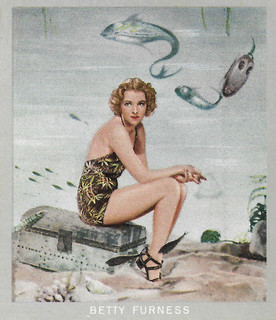
German cigarette card by Ross Verlag in the 'Künstler im Film' series for Zigarettenfabrik Monopol, Dresden, Serie 1, image 199 (of 200). Photo: Metro-Goldwyn-Mayer.
Betty Furness (1916-1994) was an American actress, a consumer advocate, and a current affairs commentator.
The Ross Tribute will be continued next week!

German cigarette card by Ross Verlag in the 'Künstler im Film' series for Zigarettenfabrik Monopol, Dresden, Serie 1, image 1. Photo: Ufa.
Beautiful Lída Baarová (1914-2000) was a glamorous Czech film star who worked in Prague, Berlin, and Rome. A dangerous affair with Joseph Goebbels, the propaganda minister of the Third Reich, first enhanced and later seriously damaged her career.

German cigarette card by Ross Verlag in the 'Künstler im Film' series for Zigarettenfabrik Monopol, Dresden, Serie 1, image 8. Photo: Metro-Goldwyn-Mayer.
Conchita Montenegro (1911-2007) was a Spanish model, dancer, and stage and screen actress. She starred in several Spanish productions, but also in French, German and American films.

German cigarette card by Ross Verlag in the 'Künstler im Film' series for Zigarettenfabrik Monopol, Dresden, Serie 1, image 13 (of 200). Photo: Ufa.
German actress Carola Höhn (1910-2005) had a 60 years lasting film career. She began as the elegant star of many Ufa productions and later became the acclaimed Grande Dame of the German post-war cinema.

German cigarette card by Ross Verlag in the 'Künstler im Film' series for Zigarettenfabrik Monopol, Dresden, Serie 1, image 18. Photo: Metro-Goldwyn-Mayer. Greta Garbo in The Painted Veil (Richard Boleslawski, 1934).
Swedish Greta Garbo (1905-1990) was one of the greatest and most glamorous film stars ever produced by the Hollywood studio system. She was part of the Golden Age of the silent cinema of the 1920s and was one of the few actors who made a glorious transition to the talkies. She started her career in the European cinema and would always stay more popular in Europe than in the USA.

German cigarette card by Ross Verlag in the 'Künstler im Film' series for Zigarettenfabrik Monopol, Dresden, Serie 1, image 30 (of 200). Photo: Itala-Film.
Hungarian actress Käthe von Nagy (1904-1973) started as the ‘Backfish’ of German films of the late 1920s. In the early 1930s, she became a fashionable and charming star of German and French cinema.

German cigarette card by Ross Verlag in the 'Künstler im Film' series for Zigarettenfabrik Monopol, Dresden, Serie 1, image 39 (of 200). Photo: Ufa.
Egyptian-born singer, dancer, and actress of Hungarian descent Marika Rökk (1913-2004) was the last film diva of the Ufa. She was an immensely talented musical performer who could tap with the rhythm and vitality of her Hollywood counterpart Eleanor Powell, and switch to balletic movements with the conviction of Cyd Charisse. Her trademark was her Hungarian accent.

German cigarette card by Ross Verlag in the 'Künstler im Film' series for Zigarettenfabrik Monopol, Dresden, Serie 1, image 41 (of 200). Photo: Gloria-Syndikat.
Glamorous, mysterious diva Zarah Leander (1907-1981) was a Swedish actress and singer, who is now best remembered for her German songs and films from the late 1930s and early 1940s. With her fascinating and deep voice, she sang melancholic and a bit frivolous songs that were specifically composed for her. Zarah was for a time the best-paid film star of the Third Reich. In her Ufa vehicles, she always played the role of a cool femme fatale, independently minded, beautiful, passionate, self-confident and a bit sad. It gave her the nickname 'the Nazi Garbo', but a recent book claims that she was, in fact, a Soviet spy.

German cigarette card by Ross Verlag in the 'Künstler im Film' series for Zigarettenfabrik Monopol, Dresden, Serie 1, image 88 (from 200). Photo: Metro-Goldwyn-Mayer. Greta Garbo in Camille (George Cukor, 1936).
Swedish Greta Garbo (1905-1990) was one of the greatest and most glamorous film stars ever produced by the Hollywood studio system. She was part of the Golden Age of the silent cinema of the 1920s and was one of the few actors who made a glorious transition to the talkies. She started her career in the European cinema and would always stay more popular in Europe than in the USA.

German cigarette card by Ross Verlag in the 'Künstler im Film' series for Zigarettenfabrik Monopol, Dresden, Serie 1, image 104 (of 200). Photo: 20th Century Fox.
American actress Sally Eilers (1908-1978) was a popular Hollywood star in the early-1930s. She was tagged 'the most beautiful girl in movies'.

German cigarette card by Ross Verlag in the 'Künstler im Film' series for Zigarettenfabrik Monopol, Dresden, Serie 1, image 110 (of 200). Photo: Manassé-Ricoll. Hans Moser in Der Dienstmann (Adolf Rosen, 1932).
Austrian actor Hans Moser (1880-1964) appeared in over 150 films. During his long career, from the 1920s up to his death, he became very popular as the mumbling factotum in comedy films. Moser was particularly associated with the genre of the Wiener Film.

German cigarette card by Ross Verlag in the 'Künstler im Film' series for Zigarettenfabrik Monopol, Dresden, Serie 1, image 115 (of 200). Photo: Dührkoop.
Sexy German dancer and film actress La Jana (1905-1940) was the most popular showgirl in Berlin in the 1930s. She appeared in 25 European films, often dancing in exotic costumes. In 1940, she suddenly died of pneumonia and pleurisy.

German cigarette card by Ross Verlag in the 'Künstler im Film' series for Zigarettenfabrik Monopol, Dresden, Serie 1, image 116 (of 200). Photo: Fox-Film.
American actress Sally Eilers (1908-1978) was a popular Hollywood star in the early-1930s. She was tagged 'the most beautiful girl in movies'.

German cigarette card by Ross Verlag in the 'Künstler im Film' series for Zigarettenfabrik Monopol, Dresden, Serie 1, image 121. Photo: Ariel / Tobis / Rota.
Russian-born ballet dancer and actress Genia Nikolaieva (1904-2001) worked in the German cinema during the 1930s. In 1938 she emigrated to the United States, where she became ‘one of the most beautiful studio secretaries for Warner Bros'.

German cigarette card by Ross Verlag in the 'Künstler im Film' series for Zigarettenfabrik Monopol, Dresden, Serie 1, image 125 (of 200). Photo: Trenker / Tobis / Rota.
Luis Trenker (1892-1990) was an Austrian-Italian ski champion, mountain climber, architect, film director, and actor. He portrayed rugged, daring outdoorsmen in the Mountain Film, the genre which seemed to be created especially for him. His films glorified epic struggles such as colonization and wars for freedom and were set against spectacular, usually mountainous landscapes.

German cigarette card by Ross Verlag in the 'Künstler im Film' series for Zigarettenfabrik Monopol, Dresden, Serie 1, image 130. Photo: Ufa
Grethe Weiser (1903-1970) was a German singer, comedian, film and stage actress. She made more than 140 films.

German cigarette card by Ross Verlag in the 'Künstler im Film' series for Zigarettenfabrik Monopol, Dresden, Serie 1, image 133 (of 200). Photo: Binder, Berlin.
Viktor de Kowa (1904-1973) was a German actor, singer, director and comedy writer. In the 1930s he became one of the most prominent and beloved comedy actors of the German cinema.

German cigarette card by Ross Verlag in the 'Künstler im Film' series for Zigarettenfabrik Monopol, Dresden, Serie 1, image 134 (of 200). Photo: Paramount.
Ketti Gallian (1912-1972) was a blonde French actress, who starred in films by Paramount and Fox during the 1930s. Her Hollywood career was not a success and she returned to France, where she acted in films till 1956.

German cigarette card by Ross Verlag in the 'Künstler im Film' series for Zigarettenfabrik Monopol, Dresden, Serie 1, image 141 (of 200). Photo: Paramount.
Grace Bradley (1913-2010) was a petite, seductive and sassy American actress who played 'good-time' girls in many second-feature thrillers and musicals of the 1930s and 1940s. She was the fifth and last wife of William 'Hoppalong Cassidy' Boyd.

German cigarette card by Ross Verlag in the 'Künstler im Film' series for Zigarettenfabrik Monopol, Dresden, Serie 1, image 143 (of 200). Photo: Metro-Goldwyn-Mayer Studios.
American film actress Jean Harlow (1911–1937) was one of the sex symbols of the 1930s.

German cigarette card by Ross Verlag in the 'Künstler im Film' series for Zigarettenfabrik Monopol, Dresden, Serie 1, image 146 (of 200). Photo: Paramount.
Brunette Olympe Bradna (1920-2012) was a French dancer and actress, who danced in Paris, Stockholm, New York City, and other world capitals. In Hollywood, she appeared in more than a dozen films and starred opposite Ronald Reagan, George Raft and Gary Cooper. In the majority of her films, she played the ornamental love interest of sporting champs or war heroes and had little else to do.

German cigarette card by Ross Verlag in the 'Künstler im Film' series for Zigarettenfabrik Monopol, Dresden, Serie 1, image 148 (of 200). Photo: Paramount.
Maurice Chevalier (1888-1972) was a French actor, singer, and entertainer with a very successful Hollywood career. His trademark was a casual straw hat, which he always wore on stage with a cane and a tuxedo.

German cigarette card by Ross Verlag in the 'Künstler im Film' series for Zigarettenfabrik Monopol, Dresden, Serie 1, image 152 (of 200). Photo: Paramount. Lupe Velez in The Broken Wing (Lloyd Corrigan, 1932).
Lupe Velez (1908-1944), was one of the first Mexican actresses to succeed in Hollywood. Her nicknames were 'The Mexican Spitfire' and 'Hot Pepper'. She was the leading lady in such silent films as The Gaucho (1927), Lady of the Pavements (1928), and Wolf Song (1929). During the 1930s, her well-known explosive screen persona was exploited in a series of successful films like Hot Pepper (1933), Strictly Dynamite (1934), and Hollywood Party (1934). In the 1940s, Vélez's popularity peaked after appearing in the Mexican Spitfire films, a series created to capitalise on Vélez's well-documented fiery personality. She had several highly publicised romances and a stormy marriage. In 1944, Vélez died of an intentional overdose of the barbiturate drug Seconal. Her death and the circumstances surrounding it have been the subject of speculation and controversy.

German cigarette card by Ross Verlag in the 'Künstler im Film' series for Zigarettenfabrik Monopol, Dresden, Serie 1, image 162 (of 200). Photo: Metro-Goldwyn-Mayer.
American screen legend Gary Cooper (1901-1961) is well remembered for his stoic, understated acting style in more than one hundred Westerns, comedies and dramas. He received five Oscar nominations and won twice for his roles as Alvin York in Sergeant York (1941) and as Will Kane in High Noon (1952).

German cigarette card by Ross Verlag in the 'Künstler im Film' series for Zigarettenfabrik Monopol, Dresden, Serie 1, image 164 (of 200). Photo: 20th Century Fox.
American actress Claire Trevor (1910-2000) appeared in 68 feature films from 1933 to 1982. She often played the hard-boiled blonde or another type of shady lady. She won the Oscar for Best Supporting Actress for her role in Key Largo (1948) and received nominations for her roles in Dead End (1937) and The High and the Mighty (1954). But she is now best known for John Ford's classic Western Stagecoach (1939) with John Wayne.

German cigarette card by Ross Verlag in the 'Künstler im Film' series for Zigarettenfabrik Monopol, Dresden, Serie 1, image 172 (of 200). Photo: Mondial-Film.
Austrian child actress Traudl Stark (1930) was the Shirley Temple of the German cinema. Between 1935 and 1940 she made a dozen popular films in Austria.

German cigarette card by Ross Verlag in the 'Künstler im Film' series for Zigarettenfabrik Monopol, Dresden, Serie 1, image 189 (of 200). Photo: Syndikat-Film.
Austrian actor Hans Moser (1880-1964) appeared in over 150 films. During his long career, from the 1920s up to his death, he became very popular as the mumbling factotum in comedy films. Moser was particularly associated with the genre of the Wiener Film.

German cigarette card by Ross Verlag in the 'Künstler im Film' series for Zigarettenfabrik Monopol, Dresden, Serie 1, image 192 (of 200). Photo: Metro-Goldwyn-Mayer. The Dodge Sisters in The March of Time (Charles Reisner, 1931)
The Dodge Sisters were two American showgirls, who were known in the USA and Europe during the Jazz Age as ‘the two birds of Paradise’. The Dodge Twins sang and danced dressed as birds and whistled. They seemingly emerged out of nowhere in the mid-1920s with a singing and dancing act that took Europe by storm. Beth and Betty Dodge were known for such films as Die schönsten Beine von Berlin/The most beautiful legs of Berlin (1927), Unter Ausschluß der Öffentlichkeit/Closed to the public (1927), and Wir schalten um auf Hollywood/We switch to Hollywood (1931).

German cigarette card by Ross Verlag in the 'Künstler im Film' series for Zigarettenfabrik Monopol, Dresden, Serie 1, image 199 (of 200). Photo: Metro-Goldwyn-Mayer.
Betty Furness (1916-1994) was an American actress, a consumer advocate, and a current affairs commentator.
The Ross Tribute will be continued next week!
Published on March 25, 2025 23:00
March 23, 2025
Nancy Kwan
Chinese-American actress Nancy Kwan (1939) played a pivotal role in the acceptance of actors of Asian ancestry in major Hollywood film roles. She is best known for her debut as a free-spirited Hong Kong prostitute who captivates artist William Holden in The World of Suzie Wong (1960). She followed it the next year with the hit musical, Flower Drum Song (1961). Kwan spent the 1960s commuting between film roles in America and Europe.
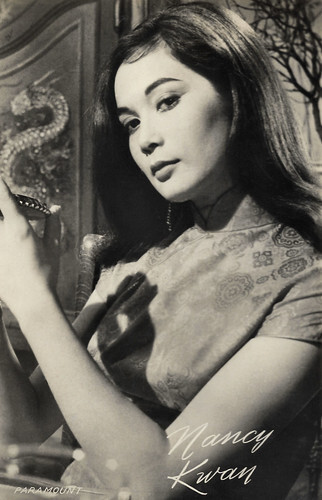
Dutch postcard by Takken, Utrecht, no. AX 4704. Photo: Paramount. Nancy Kwan in The World Of Suzie Wong (Richard Quine, 1960).
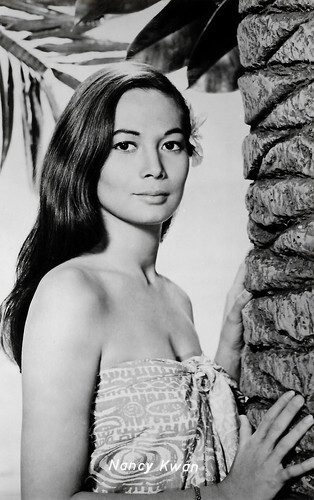
West German Kolibri postcard by Friedrich-W. Sander-Verlag, Minden/Westf., no. 2311. Nancy Kwan in Tamahine (Philip Leacock, 1963).
The World of Suzie Wong
Nancy Kwan Ka Shen (Chinese: 關家蒨) was born in Hong Kong in 1939 and grew up in Kowloon Tong. She is the daughter of Kwan Wing Hong, a Cantonese architect and Marquita Scott, a European model of English and Scottish ancestry. Kwan has an older brother, Ka Keung. In fear of the Japanese invasion of Hong Kong during World War II, Wing Hong, in the guise of a coolie, escaped from Hong Kong to North China in Christmas 1941 with his two children, whom he hid in wicker baskets. Kwan and her brother were transported by servants, evading Japanese sentries. They remained in exile in western China for five years until the war ended, after which they returned to Hong Kong and lived in a spacious, contemporary home her father designed. Scott escaped to England and never rejoined the family.
Kwan's parents divorced when she was two years old. Her mother later moved to New York and married an American. Remaining in Hong Kong with the children, her father married a Chinese woman, whom Kwan called "Mother". Her father and her stepmother raised her, in addition to her brother and five half-brothers and half-sisters. Five of Kwan's siblings became lawyers. Kwan attended the Catholic Maryknoll Convent School until she was 13 years old, after which she travelled to Kingsmoor School in Glossop, England a boarding school that her brother, Ka Keung, was then attending. Her brother studied to become an architect and she studied to become a dancer, soon also at the Royal Ballet School in London.
Afterwards, she travelled back to Hong Kong, where she started a ballet school. Stage producer Ray Stark posted an advertisement in the Hong Kong Tiger Standard (later renamed The Standard) regarding auditions for the character Suzie Wong for a play. Kwan was discovered by Stark in a film studio constructed by her architect father. After auditioning for Stark, she was asked to screen test to play a character in the film The World of Suzie Wong. Kwan did three screen tests, and a deadlock existed between whether to choose Kwan or France Nuyen , who played Suzie Wong on stage.
Owing to Kwan's lack of acting experience, at Stark's request, she travelled to the United States, where she attended acting school in Hollywood and resided in the Hollywood Studio Club, a chaperoned dormitory, with other junior actresses. She later moved to New York. Kwan signed a seven-year contract with Stark's Seven Arts Productions at a beginning salary of $300 a week though she was not given a distinct role. When 'The World of Suzie Wong' began to tour, Kwan was assigned the part of a bargirl. In addition to her small supporting character role, Kwan became an understudy for France Nuyen . Though Stark and the male lead William Holden preferred Kwan, despite her somewhat apprehensive demeanour during the screen test, she did not get the role. Paramount favoured the eminent France Nuyen , who had been widely praised for her performance in the film South Pacific (Joshua Logan, 1958). Stark acquiesced to Paramount's wishes.
Nuyen received the role and Kwan later took the place of Nuyen on Broadway. In a September 1960 interview with Associated Press journalist Bob Thomas, she said, "I was bitterly disappointed, and I almost quit and went home when I didn't get the picture." In 1959, one month after Nuyen was selected for the film role and while Kwan was touring in Toronto, Stark told her to screen test again for the film. Nuyen, who was in an unstable relationship with Marlon Brando , had a nervous breakdown and was fired from the role because of her erratic actions. The film's director, Jean Negulesco, was fired and replaced by Richard Quine. Kwan began filming in London with co-star William Holden .
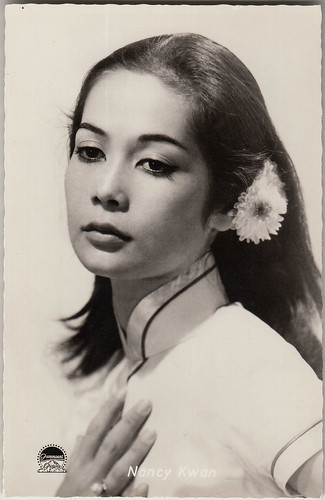
German postcard by Kolibri-Verlag G.m.b.H., no. 1827. Photo: Paramount. Collection: Marlene Pilaete.
The Chinese Bardot
The World of Suzie Wong (Richard Quine, 1960) was a "box-office sensation". Critics lavished praise on Kwan for her performance. She was given the nickname "Chinese Bardot" for her unforgettable dance performance. Kwan and two other actresses, Ina Balin and Hayley Mills were awarded the Golden Globe for the "Most Promising Newcomer–Female" in 1960. Scholar Jennifer Leah Chan of New York University wrote that Suzie provided an Asian actress — Kwan — with the most significant Hollywood role since actress Anna May Wong 's success in the 1920s.
Nancy Kwan was on the October 1960 cover of Life, cementing her status as an eminent sex symbol in the 1960s. In 1961, Kwan starred in Flower Drum Song (Henry Koster, 1961) in a related role. The film, based on the Broadway musical by Rodgers and Hammerstein, was distinguished for being the first major Hollywood feature film with an all-Asian cast. It would be also the last film to do so for more than 30 years. Her prior ballet education provided a strong foundation for her role in Flower Drum Song, where she had much space to dance.
After starring in The World of Suzie Wong and Flower Drum Song, Kwan's fame peaked in 1962. As a Hollywood icon, Kwan lived in a house atop Laurel Canyon in Los Angeles. She commuted in a white British sports car and danced to Latin verses. The 22-year-old Kwan was dating Swiss actor Maximilian Schell . Kwan's success in her early career was not mirrored in later years, due to the cultural nature of 1960s America. Kwan had to journey to Europe and Hong Kong to escape the ethnic typecasting in Hollywood that confined her largely to Asian roles despite her Eurasian appearance.
Her third film was the British drama The Main Attraction (Daniel Petrie, 1962) with Pat Boone. She played an Italian circus performer who was the love interest of Boone's character. While she was filming in the Austrian Alps, she met Peter Pock, a hotelier and ski teacher, with whom she immediately fell in love. After several weeks, the two married and resided in Innsbruck, Austria. Kwan later gave birth to Bernhard 'Bernie' Pock. Her contract with Seven Arts led her to travel around the world to make films. In 1963, Kwan starred as the title character of the comedy Tamahine (Philip Leacock, 1963), opposite Dennis Price . She played an English-Tahitian ward of the headmaster at an old English public school.
In the aviation disaster film Fate Is the Hunter (Ralph Nelson, 1964), her seventh film, Kwan played an ichthyologist opposite Glenn Ford . It was her first role as a Eurasian character. Kwan's roles were predominantly comic characters. She divorced Peter Pock in 1968. Kwan met Bruce Lee when he choreographed the martial arts moves in the spy comedy The Wrecking Crew (Phil Karlson, 1969), starring Dean Martin as Matt Helm. In Kwan's role in the film, she fought the character played by Sharon Tate by throwing a flying kick. Her martial arts move was based not on karate training, but on her dance foundation. In 2019, the film was referenced and briefly seen in Quentin Tarantino 's film Once Upon a Time in Hollywood, in which Tate is shown enjoying the film at the Fox Bruin Theater. Kwan became close friends with Lee and met his wife and two children. In the 1970s, both Kwan and Lee returned to Hong Kong, where they carried on their companionship
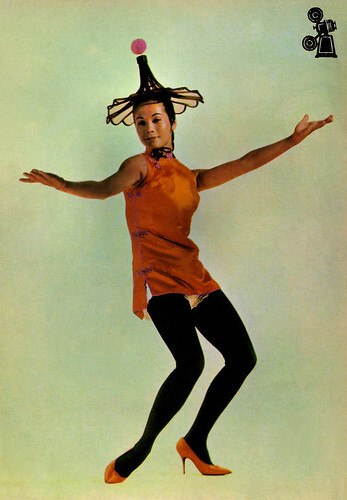
Spanish postcard by Postalcolor, Hospitalet (Barcelona), no. 123, 1964. Photo: Sirman Press. Nancy Kwan in Flower Drum Song (Henry Koster, 1961).
A horrible racist film?
Nancy Kwan married Hollywood scriptwriter David Giler in July 1970 in a civil ceremony in Carson City, Nevada. That year, Kwan returned to Hong Kong with her son because her father was sick. She initially intended to remain for one year to assist him, but ultimately remained for about seven years. In 1972 she divorced Giler. She did not stop her work, starring as Dr. Sue in the action film Wonder Women (Robert Vincent O'Neil, 1973), Supercock (Gus Trikonis, 1975), and Fear/Night Creature (Lee Madden, 1978) with Donald Pleasance and Ross Hagen. The latter introduced her to filmmaker Norbert Meisel, who became her third husband.
While in Hong Kong, Kwan founded a production company, Nancy Kwan Films, which made dozens of commercials for the Southeast Asia market. In 1979, she returned to the United States, because Kwan wanted her son Bernie to finish his schooling there. There she played characters in the television series Fantasy Island (1978), Knots Landing (1984), and The A-Team (1986). In 1987, Nancy Kwan co-owned the dim sum restaurant, Joss. Kwan, producer Ray Stark, restaurateur and Hong Kong film director Cecile Tang financed the restaurant, located on the Sunset Strip in West Hollywood.
In 1993, Kwan played Gussie Yang, a tough-talking, soft-hearted Hong Kong restaurateur, in the fictional Dragon: The Bruce Lee Story (Rob Cohen, 1993), starring Jason Scott Lee. She played a pivotal role in the film, a character based on Seattle restaurateur and political leader Ruby Chow who hired Bruce Lee as a dishwasher and gave him the funds to open a martial arts school. She also wrote, directed, and starred in a film about Eurasians, Loose Woman With No Face (Nancy Kwan, 1993). She was asked about whether she was confronted with racism as a leading Asian Hollywood actress in the 1960s. Kwan replied, "That was 30 years ago and (prejudice) wasn't such a heavy issue then. I was just in great Broadway productions that were turned into films. I personally never felt any racial problems in Hollywood."
In the 1990s, she faced a severe shortage of strong roles. She attributed this to both her age and the movie enterprise's aversion to selecting Asians for non-Asian roles. In earlier years, she was able to play an Italian and a Tahitian. She passed on a role in The Joy Luck Club (1993) because the filmmakers refused to excise a line calling The World of Suzie Wong a "...horrible racist film". In 1993, Kwan co-starred in the two-character play 'Arthur and Leila' about two siblings who struggle with their Chinese identities, and in 1994 she assumed the role of 52-year-old Martha in Singapore Repertory Theatre's showing 'Who's Afraid of Virginia Woolf?' by Edward Albee. She and her husband produced the feature film Rebellious/Biker Poet (1995) of which her son Bernie Pock was the director and an actor. In 1996, when he was 33, Bernie, died of AIDS. He contracted HIV from his wife who had gotten it from a blood transfusion. Four years after his death, poet and actress Amber Tamblyn compiled her debut poetry book 'Of the Dawn' and dedicated it to Pock. She acted in the film Biker Poet with him when she was nine.
Into the 1990s, Kwan appeared in television commercials and appeared in infomercials as the spokesperson for the cosmetic Oriental Pearl Cream. Kwan has been involved in philanthropy for AIDS awareness. In 1997, she published 'A Celebration of Life – Memories of My Son'. In 2006, Kwan reunited with Flower Drum Song co-star James Shigeta to perform A. R. Gurney's two-person play 'Love Letters'. Kwan appeared in the documentary Hollywood Chinese (Arthur Dong, 2007). Kwan and her husband Norbert Meisel wrote, directed, and produced Ray of Sunshine (Norbert Meisel, 2007), a Bildungsroman film starring Cheyenne Rushing and with Kwan in a supporting role. Kwan wrote an introduction for the 2008 book 'For Goodness Sake: A Novel of the Afterlife of Suzie Wong' by James Clapp. During her career, Kwan has appeared in two television series and over 50 films. Kwan currently resides in Los Angeles and has family members in Hong Kong. She later appeared in the feature Paint It Black (Amber Tamblyn, 2016), and the documentary Be Water (Bao Nguyen, 2020) about Bruce Lee . Nancy Kwan wrote with Deborah Davis an autobiography, 'The World of Nancy Kwan. A Memoir by Hollywood’s Asian Superstar', that will be published in 2025 by Hachette.
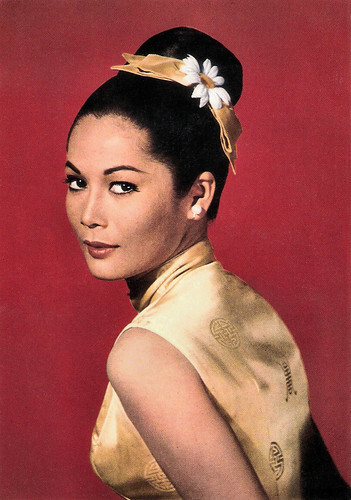
Italian postcard by Rotalfoto, Milano, no. N. 150.
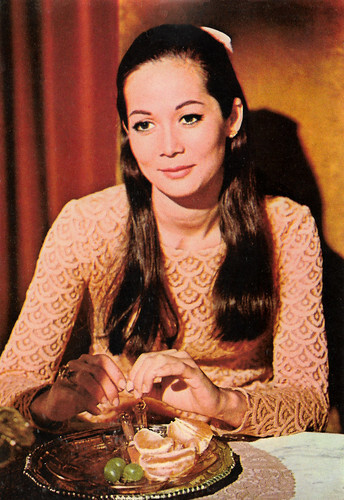
Italian postcard. Photo: Paramount. Nancy Kwan in Drop Dead Darling / Arrivederci, Baby! (Ken Hughes, 1966).
Sources: Wikipedia and .

Dutch postcard by Takken, Utrecht, no. AX 4704. Photo: Paramount. Nancy Kwan in The World Of Suzie Wong (Richard Quine, 1960).

West German Kolibri postcard by Friedrich-W. Sander-Verlag, Minden/Westf., no. 2311. Nancy Kwan in Tamahine (Philip Leacock, 1963).
The World of Suzie Wong
Nancy Kwan Ka Shen (Chinese: 關家蒨) was born in Hong Kong in 1939 and grew up in Kowloon Tong. She is the daughter of Kwan Wing Hong, a Cantonese architect and Marquita Scott, a European model of English and Scottish ancestry. Kwan has an older brother, Ka Keung. In fear of the Japanese invasion of Hong Kong during World War II, Wing Hong, in the guise of a coolie, escaped from Hong Kong to North China in Christmas 1941 with his two children, whom he hid in wicker baskets. Kwan and her brother were transported by servants, evading Japanese sentries. They remained in exile in western China for five years until the war ended, after which they returned to Hong Kong and lived in a spacious, contemporary home her father designed. Scott escaped to England and never rejoined the family.
Kwan's parents divorced when she was two years old. Her mother later moved to New York and married an American. Remaining in Hong Kong with the children, her father married a Chinese woman, whom Kwan called "Mother". Her father and her stepmother raised her, in addition to her brother and five half-brothers and half-sisters. Five of Kwan's siblings became lawyers. Kwan attended the Catholic Maryknoll Convent School until she was 13 years old, after which she travelled to Kingsmoor School in Glossop, England a boarding school that her brother, Ka Keung, was then attending. Her brother studied to become an architect and she studied to become a dancer, soon also at the Royal Ballet School in London.
Afterwards, she travelled back to Hong Kong, where she started a ballet school. Stage producer Ray Stark posted an advertisement in the Hong Kong Tiger Standard (later renamed The Standard) regarding auditions for the character Suzie Wong for a play. Kwan was discovered by Stark in a film studio constructed by her architect father. After auditioning for Stark, she was asked to screen test to play a character in the film The World of Suzie Wong. Kwan did three screen tests, and a deadlock existed between whether to choose Kwan or France Nuyen , who played Suzie Wong on stage.
Owing to Kwan's lack of acting experience, at Stark's request, she travelled to the United States, where she attended acting school in Hollywood and resided in the Hollywood Studio Club, a chaperoned dormitory, with other junior actresses. She later moved to New York. Kwan signed a seven-year contract with Stark's Seven Arts Productions at a beginning salary of $300 a week though she was not given a distinct role. When 'The World of Suzie Wong' began to tour, Kwan was assigned the part of a bargirl. In addition to her small supporting character role, Kwan became an understudy for France Nuyen . Though Stark and the male lead William Holden preferred Kwan, despite her somewhat apprehensive demeanour during the screen test, she did not get the role. Paramount favoured the eminent France Nuyen , who had been widely praised for her performance in the film South Pacific (Joshua Logan, 1958). Stark acquiesced to Paramount's wishes.
Nuyen received the role and Kwan later took the place of Nuyen on Broadway. In a September 1960 interview with Associated Press journalist Bob Thomas, she said, "I was bitterly disappointed, and I almost quit and went home when I didn't get the picture." In 1959, one month after Nuyen was selected for the film role and while Kwan was touring in Toronto, Stark told her to screen test again for the film. Nuyen, who was in an unstable relationship with Marlon Brando , had a nervous breakdown and was fired from the role because of her erratic actions. The film's director, Jean Negulesco, was fired and replaced by Richard Quine. Kwan began filming in London with co-star William Holden .

German postcard by Kolibri-Verlag G.m.b.H., no. 1827. Photo: Paramount. Collection: Marlene Pilaete.
The Chinese Bardot
The World of Suzie Wong (Richard Quine, 1960) was a "box-office sensation". Critics lavished praise on Kwan for her performance. She was given the nickname "Chinese Bardot" for her unforgettable dance performance. Kwan and two other actresses, Ina Balin and Hayley Mills were awarded the Golden Globe for the "Most Promising Newcomer–Female" in 1960. Scholar Jennifer Leah Chan of New York University wrote that Suzie provided an Asian actress — Kwan — with the most significant Hollywood role since actress Anna May Wong 's success in the 1920s.
Nancy Kwan was on the October 1960 cover of Life, cementing her status as an eminent sex symbol in the 1960s. In 1961, Kwan starred in Flower Drum Song (Henry Koster, 1961) in a related role. The film, based on the Broadway musical by Rodgers and Hammerstein, was distinguished for being the first major Hollywood feature film with an all-Asian cast. It would be also the last film to do so for more than 30 years. Her prior ballet education provided a strong foundation for her role in Flower Drum Song, where she had much space to dance.
After starring in The World of Suzie Wong and Flower Drum Song, Kwan's fame peaked in 1962. As a Hollywood icon, Kwan lived in a house atop Laurel Canyon in Los Angeles. She commuted in a white British sports car and danced to Latin verses. The 22-year-old Kwan was dating Swiss actor Maximilian Schell . Kwan's success in her early career was not mirrored in later years, due to the cultural nature of 1960s America. Kwan had to journey to Europe and Hong Kong to escape the ethnic typecasting in Hollywood that confined her largely to Asian roles despite her Eurasian appearance.
Her third film was the British drama The Main Attraction (Daniel Petrie, 1962) with Pat Boone. She played an Italian circus performer who was the love interest of Boone's character. While she was filming in the Austrian Alps, she met Peter Pock, a hotelier and ski teacher, with whom she immediately fell in love. After several weeks, the two married and resided in Innsbruck, Austria. Kwan later gave birth to Bernhard 'Bernie' Pock. Her contract with Seven Arts led her to travel around the world to make films. In 1963, Kwan starred as the title character of the comedy Tamahine (Philip Leacock, 1963), opposite Dennis Price . She played an English-Tahitian ward of the headmaster at an old English public school.
In the aviation disaster film Fate Is the Hunter (Ralph Nelson, 1964), her seventh film, Kwan played an ichthyologist opposite Glenn Ford . It was her first role as a Eurasian character. Kwan's roles were predominantly comic characters. She divorced Peter Pock in 1968. Kwan met Bruce Lee when he choreographed the martial arts moves in the spy comedy The Wrecking Crew (Phil Karlson, 1969), starring Dean Martin as Matt Helm. In Kwan's role in the film, she fought the character played by Sharon Tate by throwing a flying kick. Her martial arts move was based not on karate training, but on her dance foundation. In 2019, the film was referenced and briefly seen in Quentin Tarantino 's film Once Upon a Time in Hollywood, in which Tate is shown enjoying the film at the Fox Bruin Theater. Kwan became close friends with Lee and met his wife and two children. In the 1970s, both Kwan and Lee returned to Hong Kong, where they carried on their companionship

Spanish postcard by Postalcolor, Hospitalet (Barcelona), no. 123, 1964. Photo: Sirman Press. Nancy Kwan in Flower Drum Song (Henry Koster, 1961).
A horrible racist film?
Nancy Kwan married Hollywood scriptwriter David Giler in July 1970 in a civil ceremony in Carson City, Nevada. That year, Kwan returned to Hong Kong with her son because her father was sick. She initially intended to remain for one year to assist him, but ultimately remained for about seven years. In 1972 she divorced Giler. She did not stop her work, starring as Dr. Sue in the action film Wonder Women (Robert Vincent O'Neil, 1973), Supercock (Gus Trikonis, 1975), and Fear/Night Creature (Lee Madden, 1978) with Donald Pleasance and Ross Hagen. The latter introduced her to filmmaker Norbert Meisel, who became her third husband.
While in Hong Kong, Kwan founded a production company, Nancy Kwan Films, which made dozens of commercials for the Southeast Asia market. In 1979, she returned to the United States, because Kwan wanted her son Bernie to finish his schooling there. There she played characters in the television series Fantasy Island (1978), Knots Landing (1984), and The A-Team (1986). In 1987, Nancy Kwan co-owned the dim sum restaurant, Joss. Kwan, producer Ray Stark, restaurateur and Hong Kong film director Cecile Tang financed the restaurant, located on the Sunset Strip in West Hollywood.
In 1993, Kwan played Gussie Yang, a tough-talking, soft-hearted Hong Kong restaurateur, in the fictional Dragon: The Bruce Lee Story (Rob Cohen, 1993), starring Jason Scott Lee. She played a pivotal role in the film, a character based on Seattle restaurateur and political leader Ruby Chow who hired Bruce Lee as a dishwasher and gave him the funds to open a martial arts school. She also wrote, directed, and starred in a film about Eurasians, Loose Woman With No Face (Nancy Kwan, 1993). She was asked about whether she was confronted with racism as a leading Asian Hollywood actress in the 1960s. Kwan replied, "That was 30 years ago and (prejudice) wasn't such a heavy issue then. I was just in great Broadway productions that were turned into films. I personally never felt any racial problems in Hollywood."
In the 1990s, she faced a severe shortage of strong roles. She attributed this to both her age and the movie enterprise's aversion to selecting Asians for non-Asian roles. In earlier years, she was able to play an Italian and a Tahitian. She passed on a role in The Joy Luck Club (1993) because the filmmakers refused to excise a line calling The World of Suzie Wong a "...horrible racist film". In 1993, Kwan co-starred in the two-character play 'Arthur and Leila' about two siblings who struggle with their Chinese identities, and in 1994 she assumed the role of 52-year-old Martha in Singapore Repertory Theatre's showing 'Who's Afraid of Virginia Woolf?' by Edward Albee. She and her husband produced the feature film Rebellious/Biker Poet (1995) of which her son Bernie Pock was the director and an actor. In 1996, when he was 33, Bernie, died of AIDS. He contracted HIV from his wife who had gotten it from a blood transfusion. Four years after his death, poet and actress Amber Tamblyn compiled her debut poetry book 'Of the Dawn' and dedicated it to Pock. She acted in the film Biker Poet with him when she was nine.
Into the 1990s, Kwan appeared in television commercials and appeared in infomercials as the spokesperson for the cosmetic Oriental Pearl Cream. Kwan has been involved in philanthropy for AIDS awareness. In 1997, she published 'A Celebration of Life – Memories of My Son'. In 2006, Kwan reunited with Flower Drum Song co-star James Shigeta to perform A. R. Gurney's two-person play 'Love Letters'. Kwan appeared in the documentary Hollywood Chinese (Arthur Dong, 2007). Kwan and her husband Norbert Meisel wrote, directed, and produced Ray of Sunshine (Norbert Meisel, 2007), a Bildungsroman film starring Cheyenne Rushing and with Kwan in a supporting role. Kwan wrote an introduction for the 2008 book 'For Goodness Sake: A Novel of the Afterlife of Suzie Wong' by James Clapp. During her career, Kwan has appeared in two television series and over 50 films. Kwan currently resides in Los Angeles and has family members in Hong Kong. She later appeared in the feature Paint It Black (Amber Tamblyn, 2016), and the documentary Be Water (Bao Nguyen, 2020) about Bruce Lee . Nancy Kwan wrote with Deborah Davis an autobiography, 'The World of Nancy Kwan. A Memoir by Hollywood’s Asian Superstar', that will be published in 2025 by Hachette.

Italian postcard by Rotalfoto, Milano, no. N. 150.

Italian postcard. Photo: Paramount. Nancy Kwan in Drop Dead Darling / Arrivederci, Baby! (Ken Hughes, 1966).
Sources: Wikipedia and .
Published on March 23, 2025 23:00
March 22, 2025
Pollyanna (1920)
Pollyanna (1920) is an American silent film directed by Paul Powell and starring 'America's sweetheart', Mary Pickford. After her father's death, orphan Pollyanna has to live in an ill-tempered town with her stern Victorian Aunt Polly. Although Pollyanna's good deeds and incurable optimism melt all hearts in the town, Aunt Polly remains unmoved, still heartsick over an early romance with the village doctor... Pollyanna, scripted by Frances Marion, was based on a book by Eleanor H. Porter and a play by Catherine Chisholm Cushing.
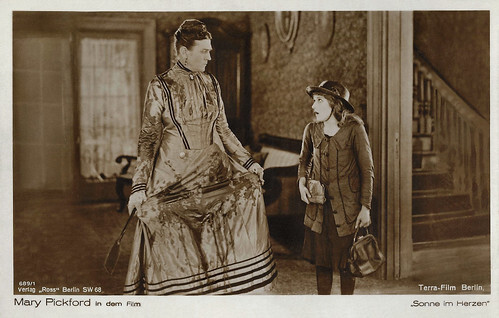
German postcard by Ross Verlag, no. 689/1, 1919-1924. Photo: Terra-Film, Berlin. Katherine Griffith as Aunt Polly and Mary Pickford as Pollyanna in Pollyanna (Paul Powell, 1920), released in Germany as Sonne im Herzen (Sunshine in her Heart).
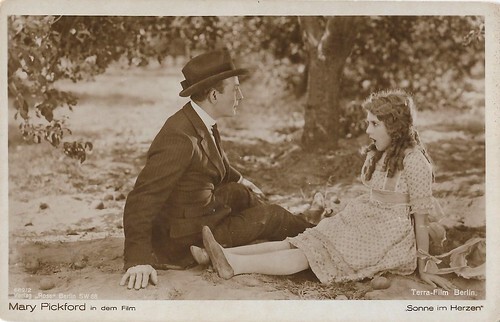
German postcard by Ross Verlag, no. 689/2. Photo: Terra-Film, Berlin. Mary Pickford in Pollyanna (Paul Powell, 1920). The man could be William Courtleigh as the neighbour, John Pendleton. She is stealing his apples but he forgives her. He discovers Pollyanna is the spitting image of her mother who left him for her father.
The glad game
Pollyanna (1920) opens in the Ozarks where a distraught Pollyanna ( Mary Pickford ) is comforting her father the Reverend John Whittier (Wharton James) as he dies. After his death, Pollyanna is sent to live on a New England plantation with her rich spinster aunt Polly (Katherine Griffith). Her aunt is extremely harsh with Pollyanna by not allowing her to speak of her father in her house and choosing the attic for her bedroom. She even takes Pollyanna shopping for new clothes. One day, while playing on the plantation, Pollyanna gets in trouble with a servant woman and runs to hide in a haystack. There she meets Jimmy Bean (Howard Ralston), an orphan her age.
Taking pity on Jimmy, Pollyanna is certain eventually Aunt Polly will let him live with them. So she hides him in the cellar. One day, Aunt Polly insists on going into the cellar, despite Pollyanna's pleas for fear Jimmy will be discovered. Jimmy is asleep and Pollyanna believes they're in the clear; until Jimmy starts shouting in his sleep, having a bad dream about turnips chasing and trying to eat him. Pollyanna is amused but Aunt Polly is not. After some pleading, Aunt Polly relents and tells Pollyanna to bring some good quilts for Jimmy.
One day, as Jimmy and Pollyanna play with the other children, they try to steal some apples from a tree belonging to John Pendleton (William Courtleigh). John catches Pollyanna in the act, but forgives her, realizing she is the exact image of her mother, a woman he once loved deeply, but she loved Pollyanna's father instead. He tells Pollyanna this as he shows her a painting of her mother. Meanwhile, Jimmy fights his way in, fearing that Pollyanna is in danger. He tries to defend her but finds that everything is normal.
As Pollyanna settles in she seems to bring optimism to those she meets. She is insistent on playing a game her father taught her called 'The Glad Game', where one counts the things they are glad for. She visits an old shut-in who is supposedly grateful for nothing. Pollyanna brings along an old blind and deaf friend who plays the accordion. Upon discovering the woman is blind and deaf, the shut-in proclaims her gratitude for still having her sight and hearing.
One day, however, Pollyanna tries to save a child from a car but is herself hit and becomes paralysed. Aunt Polly finally realises how important her niece has become to her. She learns that the only doctor who can happily operate on Pollyanna by restoring the use of her legs is Chilton, her old lover. Swallowing her pride, Polly goes to him to ask him to perform the miracle. Chilton succeeds and Pollyanna can finally walk again. The whole town rejoices as Jimmie Bean finally declares his love for her.
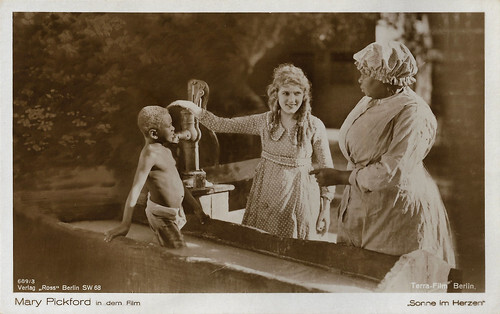
German postcard by Ross Verlag, no. 689/3. Photo: Terra-Film, Berlin. Mary Pickford in Pollyanna (Paul Powell, 1920).
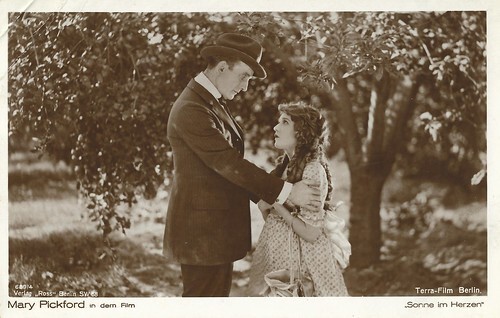
German postcard by Ross Verlag, no. 689/4. Photo: Terra-Film, Berlin. Mary Pickford in Pollyanna (Paul Powell, 1920). The man could be William Courtleigh, who plays the neighbour, John Pendleton, from whose tree Pollyanna has stolen apples. He is smitten with her as she is the lookalike of her mother, whom he once loved. She makes sure he adopts an orphan boy, Jimmy Bean (Howard Ralston), who she helped find lodgings.
Little girl pictures
Eleanor H. Porter created the character of Pollyanna in 1913 and made her the protagonist of a series of highly successful children's books. Catherine Chisholm Cushing's stage version was first staged at the Hudson Theatre on Broadway on 18 September 1916, closing in December after 112 performances. It starred the young actress Patricia Collinge, who was celebrated by audiences and critics alike for her performance.
In 1920, Eleanor H. Porter died at the age of 52. Precisely that year her character was first brought to life on screen by Mary Pickford . Pickford was then 27 years old and portrayed a 12-year-old. She had recently divorced her alcoholic husband, the actor Owen Moore and was on the verge of remarrying a second time to Douglas Fairbanks . According to the theatrical and cinematic conventions of the time, it was nonetheless common that experienced young actresses played teenage virginal leading roles, on screen as well as in the theatre.
Mary Pickford was no stranger to child roles, in fact, she had specialised in them with a long series of successful films. From Poor Little Rich Girl (Maurice Tourneur, 1917) to Rebecca of Sunnybrook Farm (Marshall Neilan, 1917), A Little Princess (Marshall Neilan, 1917), and Daddy Longlegs (Marshall Neilan, 1919). In Pollyanna , the actress again played the role of the teenager with long blond curly hair with great ease, alongside ‘real’ child actors such as Howard Ralston or Joan Marsh. In the following years, Pickford successfully played other child roles such as in Little Lord Fauntleroy (Alfred E. Green, Jack Pickford, 1921), Little Annie Rooney (William Beaudine, 1925), and Sparrows (William Beaudine, 1926).
Pollyanna (Paul Powell, 1920) was Mary Pickford's first film for United Artists, the company she helped found. The film was shot in California, Alabama Hills, Lone Pine and South Pasadena in September 1919. The Mary Pickford Company produced it with an estimated budget of $300,000. Pollyanna has a copyright year of 1919 but was first released in 1920. Pollyanna became a major success. Ron Oliver at IMDb : "This splendid family film, based on the Eleanor H. Porter classic, is as spunky & cheerful as its innocent heroine. 28-year-old Mary Pickford is wonderfully believable as a little girl. She exhibits the sweet charm which made her the world's most famous celebrity. She dominates her every scene with star quality few others ever possessed. The rest of the cast is also very good, especially Katherine Griffith as sullen Aunt Polly & Howard Ralston as young orphan Jimmy Bean. The sets & location filming are also worthy of mention.
During its first theatrical run, the film grossed $1.1 million (approximately $16,730,000 today) worldwide. It was extremely popular, became one of Mary Pickford's most defining 'little girl' pictures and made her Hollywood's first great star. A complete print of Pollyanna is preserved at the Mary Pickford Institute for Film Education. The Pickford Corporation also owns the copyright. There is also a famous film remake, Pollyanna (David Swift, 1960), produced by Disney and starring Hayley Mills and Jane Wyman . In the following decades, several television versions followed.
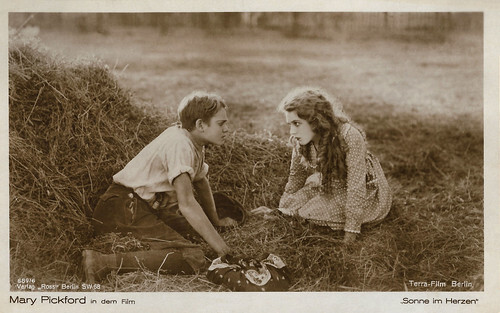
German postcard by Ross Verlag, no. 689/6, 1919-1924. Photo: Terra-Film, Berlin. Howard Ralston and Mary Pickford in Pollyanna (Paul Powell, 1920).
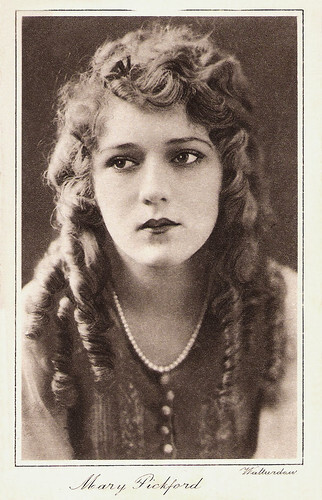
British postcard. Photo: Walturdaw.
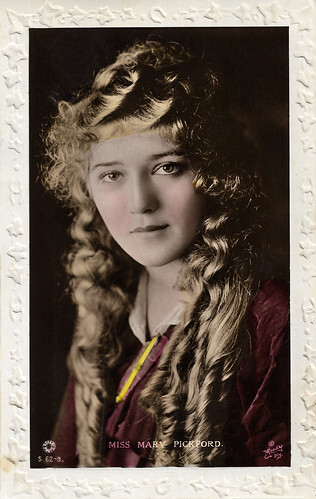
British postcard by Rotary Photo, London, no. S. 62-3. Photo: Moody, N.Y.
Sources: Ron Oliver (IMDb), Wikipedia (Dutch, Italian and English) and IMDb.

German postcard by Ross Verlag, no. 689/1, 1919-1924. Photo: Terra-Film, Berlin. Katherine Griffith as Aunt Polly and Mary Pickford as Pollyanna in Pollyanna (Paul Powell, 1920), released in Germany as Sonne im Herzen (Sunshine in her Heart).

German postcard by Ross Verlag, no. 689/2. Photo: Terra-Film, Berlin. Mary Pickford in Pollyanna (Paul Powell, 1920). The man could be William Courtleigh as the neighbour, John Pendleton. She is stealing his apples but he forgives her. He discovers Pollyanna is the spitting image of her mother who left him for her father.
The glad game
Pollyanna (1920) opens in the Ozarks where a distraught Pollyanna ( Mary Pickford ) is comforting her father the Reverend John Whittier (Wharton James) as he dies. After his death, Pollyanna is sent to live on a New England plantation with her rich spinster aunt Polly (Katherine Griffith). Her aunt is extremely harsh with Pollyanna by not allowing her to speak of her father in her house and choosing the attic for her bedroom. She even takes Pollyanna shopping for new clothes. One day, while playing on the plantation, Pollyanna gets in trouble with a servant woman and runs to hide in a haystack. There she meets Jimmy Bean (Howard Ralston), an orphan her age.
Taking pity on Jimmy, Pollyanna is certain eventually Aunt Polly will let him live with them. So she hides him in the cellar. One day, Aunt Polly insists on going into the cellar, despite Pollyanna's pleas for fear Jimmy will be discovered. Jimmy is asleep and Pollyanna believes they're in the clear; until Jimmy starts shouting in his sleep, having a bad dream about turnips chasing and trying to eat him. Pollyanna is amused but Aunt Polly is not. After some pleading, Aunt Polly relents and tells Pollyanna to bring some good quilts for Jimmy.
One day, as Jimmy and Pollyanna play with the other children, they try to steal some apples from a tree belonging to John Pendleton (William Courtleigh). John catches Pollyanna in the act, but forgives her, realizing she is the exact image of her mother, a woman he once loved deeply, but she loved Pollyanna's father instead. He tells Pollyanna this as he shows her a painting of her mother. Meanwhile, Jimmy fights his way in, fearing that Pollyanna is in danger. He tries to defend her but finds that everything is normal.
As Pollyanna settles in she seems to bring optimism to those she meets. She is insistent on playing a game her father taught her called 'The Glad Game', where one counts the things they are glad for. She visits an old shut-in who is supposedly grateful for nothing. Pollyanna brings along an old blind and deaf friend who plays the accordion. Upon discovering the woman is blind and deaf, the shut-in proclaims her gratitude for still having her sight and hearing.
One day, however, Pollyanna tries to save a child from a car but is herself hit and becomes paralysed. Aunt Polly finally realises how important her niece has become to her. She learns that the only doctor who can happily operate on Pollyanna by restoring the use of her legs is Chilton, her old lover. Swallowing her pride, Polly goes to him to ask him to perform the miracle. Chilton succeeds and Pollyanna can finally walk again. The whole town rejoices as Jimmie Bean finally declares his love for her.

German postcard by Ross Verlag, no. 689/3. Photo: Terra-Film, Berlin. Mary Pickford in Pollyanna (Paul Powell, 1920).

German postcard by Ross Verlag, no. 689/4. Photo: Terra-Film, Berlin. Mary Pickford in Pollyanna (Paul Powell, 1920). The man could be William Courtleigh, who plays the neighbour, John Pendleton, from whose tree Pollyanna has stolen apples. He is smitten with her as she is the lookalike of her mother, whom he once loved. She makes sure he adopts an orphan boy, Jimmy Bean (Howard Ralston), who she helped find lodgings.
Little girl pictures
Eleanor H. Porter created the character of Pollyanna in 1913 and made her the protagonist of a series of highly successful children's books. Catherine Chisholm Cushing's stage version was first staged at the Hudson Theatre on Broadway on 18 September 1916, closing in December after 112 performances. It starred the young actress Patricia Collinge, who was celebrated by audiences and critics alike for her performance.
In 1920, Eleanor H. Porter died at the age of 52. Precisely that year her character was first brought to life on screen by Mary Pickford . Pickford was then 27 years old and portrayed a 12-year-old. She had recently divorced her alcoholic husband, the actor Owen Moore and was on the verge of remarrying a second time to Douglas Fairbanks . According to the theatrical and cinematic conventions of the time, it was nonetheless common that experienced young actresses played teenage virginal leading roles, on screen as well as in the theatre.
Mary Pickford was no stranger to child roles, in fact, she had specialised in them with a long series of successful films. From Poor Little Rich Girl (Maurice Tourneur, 1917) to Rebecca of Sunnybrook Farm (Marshall Neilan, 1917), A Little Princess (Marshall Neilan, 1917), and Daddy Longlegs (Marshall Neilan, 1919). In Pollyanna , the actress again played the role of the teenager with long blond curly hair with great ease, alongside ‘real’ child actors such as Howard Ralston or Joan Marsh. In the following years, Pickford successfully played other child roles such as in Little Lord Fauntleroy (Alfred E. Green, Jack Pickford, 1921), Little Annie Rooney (William Beaudine, 1925), and Sparrows (William Beaudine, 1926).
Pollyanna (Paul Powell, 1920) was Mary Pickford's first film for United Artists, the company she helped found. The film was shot in California, Alabama Hills, Lone Pine and South Pasadena in September 1919. The Mary Pickford Company produced it with an estimated budget of $300,000. Pollyanna has a copyright year of 1919 but was first released in 1920. Pollyanna became a major success. Ron Oliver at IMDb : "This splendid family film, based on the Eleanor H. Porter classic, is as spunky & cheerful as its innocent heroine. 28-year-old Mary Pickford is wonderfully believable as a little girl. She exhibits the sweet charm which made her the world's most famous celebrity. She dominates her every scene with star quality few others ever possessed. The rest of the cast is also very good, especially Katherine Griffith as sullen Aunt Polly & Howard Ralston as young orphan Jimmy Bean. The sets & location filming are also worthy of mention.
During its first theatrical run, the film grossed $1.1 million (approximately $16,730,000 today) worldwide. It was extremely popular, became one of Mary Pickford's most defining 'little girl' pictures and made her Hollywood's first great star. A complete print of Pollyanna is preserved at the Mary Pickford Institute for Film Education. The Pickford Corporation also owns the copyright. There is also a famous film remake, Pollyanna (David Swift, 1960), produced by Disney and starring Hayley Mills and Jane Wyman . In the following decades, several television versions followed.

German postcard by Ross Verlag, no. 689/6, 1919-1924. Photo: Terra-Film, Berlin. Howard Ralston and Mary Pickford in Pollyanna (Paul Powell, 1920).

British postcard. Photo: Walturdaw.

British postcard by Rotary Photo, London, no. S. 62-3. Photo: Moody, N.Y.
Sources: Ron Oliver (IMDb), Wikipedia (Dutch, Italian and English) and IMDb.
Published on March 22, 2025 23:00
Paul van Yperen's Blog
- Paul van Yperen's profile
- 13 followers
Paul van Yperen isn't a Goodreads Author
(yet),
but they
do have a blog,
so here are some recent posts imported from
their feed.



